

Strategy Implementation: Process, Models & Example

Strategy implementation is the process where strategies and methods are put into action to fulfill an organization’s objectives, goals, and mission. This step comes after the strategic planning and decision-making process.
What is a Business Strategy? What are examples of business strategy?
Strategy Implementation Models
There are many different models and frameworks that can be used to guide the process of strategy implementation. Here are a few of the most commonly used models:
- Balanced Scorecard: Developed by Robert Kaplan and David Norton, this model uses a balanced set of financial and non-financial metrics to measure performance. It considers four perspectives: financial performance, customer knowledge, internal business processes, and learning and growth.
- McKinsey 7S Framework: This model emphasizes the importance of coordinating seven key organizational elements for successful implementation: structure, strategy, systems, staff, style, skills, and shared values.
- Kotter’s 8-Step Change Model: Although not a strategy-specific implementation model, John Kotter’s model is widely used in strategic change scenarios. The eight steps include creating a sense of urgency, forming a guiding coalition, creating a vision for change, communicating the vision, removing obstacles, creating short-term wins, building on the change, and anchoring the change in corporate culture.
- OKR (Objectives and Key Results): This goal-setting framework helps organizations implement the strategy by defining objectives and tracking measurable results.
- OGSM (Objectives, Goals, Strategies, Measures): This model provides a clear and visual structure to help organizations align their strategies with operational actions and expected outcomes.
- PDCA (Plan, Do, Check, Act): This iterative four-step management method is used in businesses to control and continuously improve processes and products.
- Strategy Map: A strategy map is a visual tool designed to communicate a strategic plan and achieve high-level business goals.
The best model for any given organization will depend on the nature of the organization, the specific strategies being implemented, and the context in which they operate.
Strategy Implementation Process
The strategy implementation process is a complex process that involves turning strategic plans into actions and then measuring the effectiveness of those actions in achieving the organization’s goals. Although it can vary based on specific models and business environments, a typical strategy implementation process may include the following steps:
- Developing an Implementation Plan: The first step in the process is to develop a detailed plan for implementing the strategy. This plan should clearly outline the tasks that need to be accomplished, who is responsible for each task, when each task needs to be completed, and what resources are required.
- Resource Allocation: Resources need to be efficiently allocated to support the strategy. This could involve financial resources, human resources, materials, or time. It’s also important to ensure that the organization can implement the strategy.
- Organizational Structure Adjustments: Sometimes, the existing organizational structure may need to be modified or redesigned to support the strategic goals. This could involve changes in roles, responsibilities, reporting lines, etc.
- Strategy Communication: It’s important to communicate the strategy across the organization. All employees should understand the strategy, their role in it, and how their work contributes to strategic objectives.
- Employee Training and Development: Employees may need new skills or knowledge to carry out their roles under the new strategy. This might require training, mentoring, or hiring new staff.
- Performance Management: Set clear performance standards and Key Performance Indicators (KPIs) to monitor progress toward strategic objectives. Regularly review performance and provide feedback.
- Leadership and Management Support: Leaders and managers should commit to the strategy, set a good example, and motivate their teams.
- Review and Adjust: Strategy implementation is not a one-time activity. Regularly review progress and make necessary adjustments. This might involve changing aspects of the strategy, altering the implementation plan, or reallocating resources.
Strategy implementation can be challenging, but following a structured process can increase the chances of success. Remember that effective strategy implementation requires a long-term commitment and the ability to adapt to changing circumstances.
Strategy Implementation Example
Let’s look at an example of a company implementing a new strategy. This example is hypothetical and simplified but gives a basic idea of the process.
Company ABC, a retail business, has decided to implement a new strategy of focusing more on e-commerce sales to adapt to the increasing trend of online shopping. Here’s how they could implement this strategy:
- Develop an Implementation Plan: ABC creates a detailed plan with objectives such as developing a user-friendly online shopping platform, increasing the online product range, and implementing digital marketing campaigns.
- Resource Allocation: ABC allocates funds for website development, digital marketing, and e-commerce logistics. They also allocate personnel resources, assigning teams to manage the new online shopping platform, customer service, and digital marketing.
- Organizational Structure Adjustments: ABC modifies its organizational structure, establishing a new e-commerce department and hiring a Head of E-commerce.
- Strategy Communication: ABC’s CEO communicates the new strategy to all employees through a town hall meeting. They explain the strategic shift, its reasons, and how it affects different parts of the organization.
- Employee Training and Development: ABC arranges training programs for its customer service and sales teams to help them adapt to the new e-commerce environment. They also hire new staff with digital marketing and e-commerce experience.
- Performance Management: ABC sets KPIs related to online sales volume, website traffic, and customer satisfaction rates. They introduce a performance dashboard to track these metrics.
- Leadership and Management Support: ABC’s management team fully supports the new strategy. They lead by example, show enthusiasm and commitment, and regularly update staff on progress.
- Review and Adjust: After the first quarter, ABC reviews the results. They see an increase in online sales, but customer feedback indicates some issues with the new online platform. ABC takes this feedback and makes necessary adjustments, enhancing the website’s user interface and fixing technical bugs.
This example demonstrates the importance of planning, resource allocation, organizational adjustments, communication, and ongoing review in the strategy implementation process. It’s also worth noting that even well-planned strategies may need adjustments based on feedback and performance results.
Related Posts

The Art of Persuasion: Techniques for Influencing Buying Decisions

Organizational Culture: Defining | Improving | Examples

Organizational Restructuring: Meaning | Process | Examples

Examples of supply chain strategy

Entire Supply Chain Strategy Explained

Succession Planning Process in Business

Stability Strategy in Business: Meaning | Types | Examples

Balanced Scorecard | Explained with Examples
Type above and press Enter to search. Press Esc to cancel.
Strategic Implementation: More Than Just Implementing Strategy
By Kate Eby | November 27, 2017 (updated December 4, 2021)
- Share on Facebook
- Share on Twitter
- Share on LinkedIn
Link copied
Strategic implementation is a key ingredient of modern business: Once an organization creates a strategy to meet its goals, implementation is the next step for successful execution. Essentially, the implementation phase outlines how a company plans to achieve its goals. Business theories and frameworks help guide strategic formulation, implementation, and execution. This article explains strategic implementation and how it differs from other strategy tactics. You’ll learn about key steps and pitfalls, review some examples, and get expert insights.
What Is Strategic Implementation?
There are numerous definitions of strategic implementation on the web, including the following:
Business Dictionary : The activity performed according to a plan in order to achieve an overall goal. For example, strategic implementation within a business context might involve developing and then executing a new marketing plan to help increase sales of the company's products to consumers.
The Houston Chronicle : The process that puts plans and strategies into action to reach goals. A strategic plan is a written document that lays out the plans of the business to reach goals, but will sit forgotten without strategic implementation. The implementation makes the company’s plans happen.
OnStrategy : The process that turns strategies and plans into actions in order to accomplish strategic objectives and goals.
What these and other definitions have in common is that they discuss turning a theoretical plan (about an organization’s direction) into manageable tasks that team members can perform to achieve the stated goals.
Once an organization creates a strategy, it needs to be implemented, and then executed. Here are the high-level steps in strategic implementation (which we will discuss in detail later):
- Communicate
- Align initiatives with strategy
- Engage staff and outside stakeholders
- Allocate resources
- Make structural adjustments
- Create strategic evaluations
Strategy Implementation vs. Strategic Implementation
Whether or not a difference exists between strategy implementation and strategic implementation depends on who you ask.

Ray Mckenzie, Founder and Managing Director of Red Beach Advisors , says, “Strategy implementation is a larger umbrella, or a holistic view of what’s going to happen, and looks at products and pricing and how we function as business. Strategic implementation is a plan for implementation of a specific objective: For example, if I have a piece of software that I want installed in three months.” One scenario might be if you want to integrate CRM software into your organization, you’ll need to identify the steps to take to execute the integration.

Lloyd Baird is the Jon M. Huntsman Visiting Professor at Utah State University . Of the difference between the two phrases, he says, “It depends on what organization or company you are talking to.”
In this article, we’ll treat strategy implementation and strategic implementation as synonymous.
Getting Strategic
As organizations evolve, they often change from a reactive to proactive operational style. It’s at this point that an organization begins strategic planning, which leads to strategic implementation.
Formulation, Implementation, and Execution
Strategy formulation (also known as planning), implementation, and execution are intertwined, but each are distinct. Formulation is the creation of a framework that guides decisions. Implementation is preparation and putting elements of the strategy into place. Execution is the decisions made and activities performed throughout the company, with the objective of meeting goals outlined in the strategy.
For example, imagine you're the coach of a football team in a critical 4th-and-1 situation. In this case, the terms would function as follows:
- Formulation: You select a play from your playbook, with the objective of getting a first down.
- Implementation: The players position themselves on the field as outlined in the chosen play, and you place the best offensive linemen up front, and the sturdiest running back in the backfield.
- Execution: The ball is snapped, the linemen push their defensive counterparts back, and if all goes well, they open up enough ground so that when the running back gets the handoff, he can move it across the line of scrimmage for a first down.
Smartsheet offers many templates to assist with strategic formulation.
Thinking About Strategic Implementation
In his paper Strategy Implementation as Substance and Selling , author Donald C. Hambrick and Albert A. Cannella, Jr., state “… implementation must be considered during the formulation process, not later, when it may be too late.” They continue, “The strategist will not be able to nail down every action step when the strategy is first created, nor … should this even be attempted. However, he or she must have the ability to look ahead at the major implementation obstacles and ask, ‘Is this strategy workable?’”
Corporate Strategy and Business Unit Strategy
Executives create the corporate strategy, which determines the company’s lines of business. It also addresses how business units can work together to increase efficiency. Business unit strategy is created by the leader of each unit, and revolves around how the corporate strategy is put into action. In other words, corporate strategy determines what happens, and business unit strategy determines how it happens.
To align corporate and business unit strategies, executives must encourage the development of business unit strategies that both contribute to corporate strategy objectives and respond to their competitive situation, whether geographical or functional.
In a 1984 paper titled Business Unit Strategy, Managerial Characteristics, and Business Unit Effectiveness at Strategy Implementation , authors Anil K. Gupta and V. Govindarajan explain, “The absolute performance of a business entity depends not just on the effectiveness of its internal organization in implementing the chosen strategy, but also on industry characteristics and the choice of strategy itself.”
Top tips to help you save time and money on your next project.
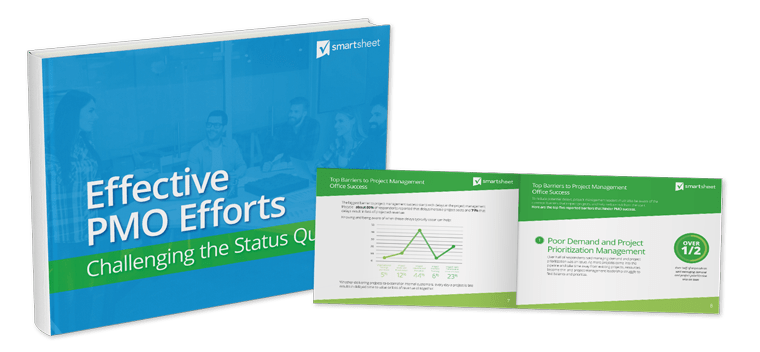
Discover five ways to decrease project delays and increase revenue so you can eliminate the barriers to PMO success and ensure your projects stay on track.
Get the free e-book to see how my efforts compare
Why Is Implementation Important?
Executives formulate the strategy that business units will execute. However, implementation requires the participation of the entire organization, so implementation is as important — if not more so — than the strategy itself. For example, you can buy seeds and plant them in your garden with the goal of serving a home-grown salad every night at dinner, but that doesn’t ensure that you’ll reach your goal. If you plant at the wrong time of year, if the seeds are not viable in your climate, or if the soil is depleted, you’ll still be buying vegetables from the store for a long time to.
Because strategic implementation is the most important, it’s also the most difficult to achieve. A 1989 Booz Allen study found that 73 percent of managers thought that strategic implementation is more difficult than formulation, 72 percent think that it takes more time, and 82 percent say it’s the part of the process over which they have the least control. But there’s been progress. In a 2015 survey of reports titled Strategy implementation: What is the failure rate? , authors Carlos J.F. Cândido and Sérgio P. Santos conclude that the implementation failure rate has fallen from the between 70-90 percent in the mid 1980s to about 44 percent in the early 2010s.
There are many reasons that strategies can fail. A bad plan (e.g. one that has unrealistic goals), or poor execution (e.g. not adapting to changing conditions) can cause failure, but since implementation is the key aspect, there are more possible pitfalls, including the following:
- Stakeholders Don’t Buy-In: Those who are responsible for executing a strategy won’t want to do it if they don’t believe in it. Ray McKenzie says, “Not having completed buy-in from the team is first and foremost. If people don’t buy-in, it won’t get completed.”
- Resources Aren’t Aligned with Strategy: For example, if you want to sell red balloons, but fill your warehouse with blue ones, you won’t meet your goals.
- Incentives Aren’t Aligned with the Strategy: This happens when you reward people for completing tasks that don’t contribute toward the key performance indicators (KPIs) .
- You Don’t Plan to Adjust: Lloyd Baird says, “There’s an old military saying: Your battle plan is great until you contact the enemy, then everything changes. Things are changing so fast in organizations that if you don’t have a method to adapt, evaluate, and change, you’re going to fail. The people that are really good are the ones who are adapting along the way.”
- Continuing To Do Things that Used To Work: Rather than relying on old mechanisms for success, stay current with trends and tools.
- Internal Politics: Turf battles or personal disputes can prevent an organization from properly implementing a strategy.
- Accountability Void: When implementing a strategy, everybody involved must be made aware of their responsibilities, and the consequences of not meeting them.
- No Milestones: As Ray McKenzie explains, “A strategy only works for a period of time — you have to have an outline of those dates.”
- Lack of Empowerment: This happens when people and teams aren’t given the authority, resources, and tools to execute the strategy.
- Communication Breakdown: If the organization is not sharing the strategy, or is sharing it in the wrong ways, the team won’t understand it.
Challenges and Criticisms of Strategic Implementation
Like any business process, strategic implementation has its share of challenges and criticisms. However, if an organization is aware of the limitations of strategic implementation and the obstacles that may arise, they can overcome potential challenges.
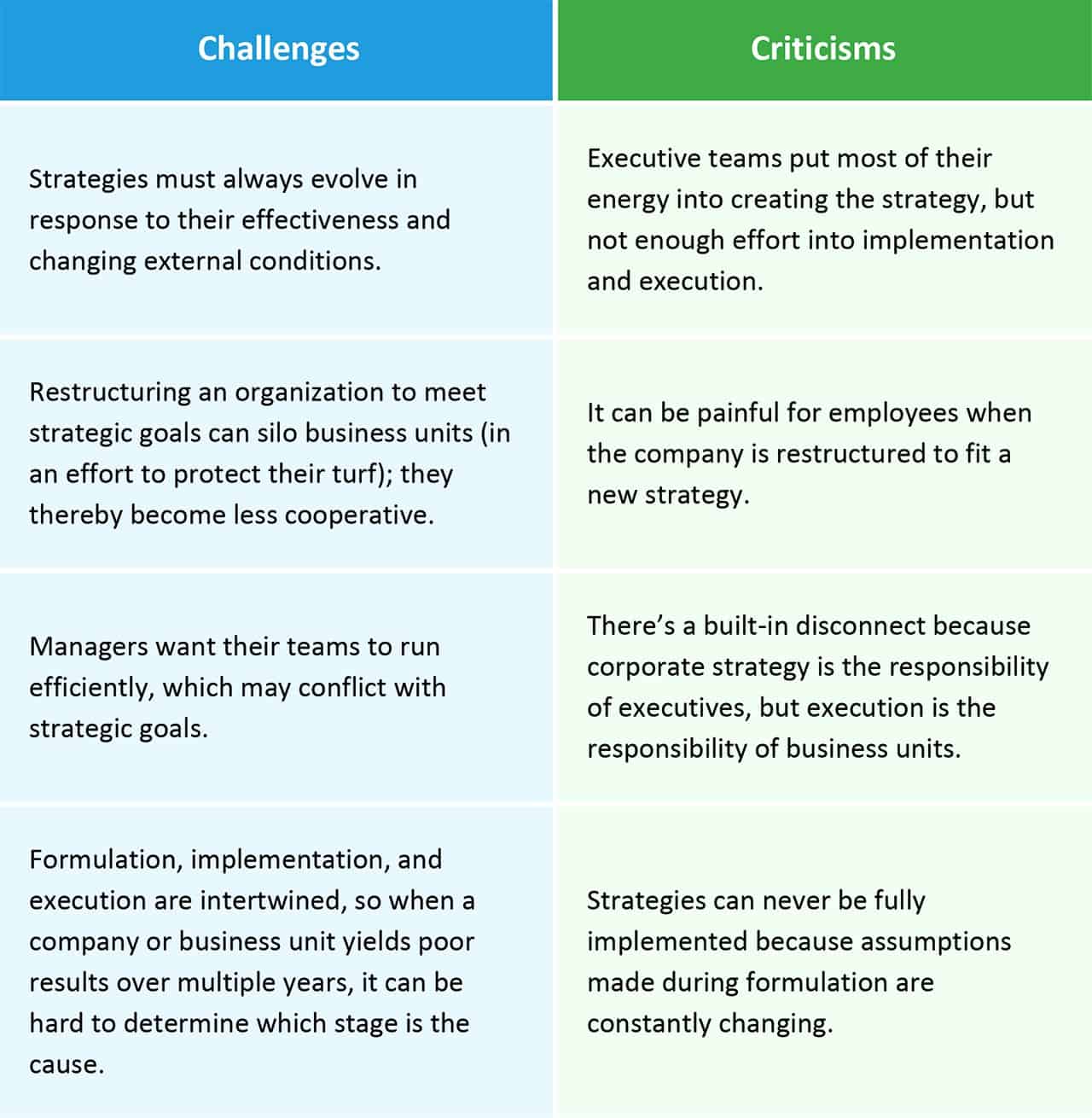
Key Leadership Theories for Implementation Strategy
Leadership theories guide how executives think about the world and their organization’s place in it. A couple important, related theories are discussed below.
Tipping Point Theory
- What It Is: The nce a critical mass of people gets behind something, it spreads quickly. Malcolm Gladwell’s 2000 book, The Tipping Point, provides many examples of this theory in action, from the changes in the Bill Bratton-led NYPD in the 1990s that resulted in a dramatic drop in crime, to the way Hush Puppies shoes became popular again once key people in the fashion world started wearing them. The makeup of a critical mass will vary by organization: It could be a majority, or it could be a small group of influential people.
- How It Can Help with Strategic Implementation: While implementing a strategy, executives can identify what constitutes a critical mass in each business unit, and work to get those people invested in the strategy. Once those team members are on board, they’ll bring the rest of the team along.
Blue Ocean Theory
- What It Is: It sprang out of a marketing theory with the same name, which posits that companies should create opportunities in market areas where there isn’t much competition to provide greater growth opportunities. For example, Southwest Airlines became a major player by combining customer-focused service, low prices (partly achieved by flying from secondary airports and partly by using only a single aircraft), and flying to underserved areas. As a leadership theory, Blue Ocean tasks leaders with undertaking the activities that increase team performance, listening to feedback from all parts of their organization, and developing leaders at all levels.
- How It Can Help with Strategic Implementation: Having leaders at many levels focus on activities that increase team performance and listen to every level, the strategies they develop will be easier to implement. This method helps the leaders generate some built-in buy-in. By walking the leadership walk, others are more likely to follow along.
What Do You Mean by Strategic Evaluation?
Strategic evaluation is a type of business performance measurement (BPM) system. In a 2007 paper Towards A Definition of a Business Performance Measurement System , Monica Franco-Santos et al. describes it as, “...a set of metrics used to quantify both the efficiency and effectiveness of actions; or as the reporting process that gives feedback to employees on the outcome of actions.” Strategic evaluation (often written as strategic evaluation and control, when it’s used as part of a strategic management model) is a cyclical process that helps managers and executives determine whether programs, projects, and activities are helping an organization meet their strategy’s goals and objectives. In short, it can help an organization stay on and get back on track.
Strategic evaluation is performed during the execution phase, but you create the process during implementation. There’s always a need to get and analyze feedback to find out what is and isn’t working, identify ways to fix what’s not working, and record the lessons learned for future strategies. There are four high-level steps in the strategic evaluation process:
- Set benchmarks
- Compare results against benchmarks
- Analyze the differences
- Take corrective actions
There are a few different facets of strategic evaluation. Each facet is important and shouldn't be ignored, as using all four ensure that you’ll discover any possible root causes of a problem.
- Premise: Were the strategic goals realistic and achievable?
- Implementation: Was the process of implementing organizational changes based on the strategy performed properly?
- Strategic Surveillance: Are processes and tasks being performed as expected, and if so, are they getting the desired results?
- Special Alerts: While strategic evaluation should take the long view, and not focus too much on short-term fluctuations, it needs to evaluate how changing market conditions and competitors’ actions, as well as unexpected events, affect the strategy. Taking this view will highlight those surprises and changes — then you can implement contingency plans and bring in crisis management teams if required to change the strategy’s execution.
Strategic evaluations are a great way to learn. Ray McKenzie says, “Have a follow-up with the team to see what worked, or if you should do things differently next time around."
How Strategic Implementation Works in Different Organizations
With the rise of mass production in the 19th century, companies began to centralize key functions like sales and finance, which led to economies of scale. Later, as some firms became diversified and began to increase their market, they created business units that focused on product lines or geographical regions. The firms may have lost some of the previously gained economies of scale, but they were able to better react to market conditions.
Centralized organizations could use strategic implementation to make shared services more efficient. Diversified organizations could coordinate processes and goals between various regional offices or product-focused groups.
Later, companies started using the matrix organization to try to take advantage of both the economies of scale created by centralization, and the adaptability of the geographical or product-focused organizations. Matrix organizations are difficult to coordinate. Implementing a strategy can help everyone focus on the same goals.
In the 1990s, the business process reengineering (a version of this is know as Total Quality Management, or TQM ) drove the creation of organizations that were organized around processes. Again, implementing a strategy can help everyone focus on the same goals.
Going forward, virtual, networked, and “Velcro” organizations (a concept where the organization can be pulled apart and put back together in response to changes in the business environment, or as Lloyd Baird says, “a network of relationships”) will have the same issues that strong strategic implementation can help.
What Is Involved in the Implementation Process
After formulating and finalizing a strategy, it’s time to share it with the organization. Next, you may need to make changes to the organization in preparation for the execution phase. The steps to take are as follows:
Communicate: Everyone in the organization, and some outside, must learn about the strategy, how it affects them, and what changes they’ll need to make to support it. As you cascade the strategy throughout the organization, different groups will need to be made aware of the parts that are important to them. Sales and marketing teams will want to hear more about the sales goals, while IT will be more concerned about changes to the network and new required software. A vendor will need to know what changes they’ll need make to the materials they provide.
Engage Stakeholders: After communicating the goals, managers and staff (as well as any contractors or vendor affected) need to understand the importance of the strategic goals, their role in strategy execution, their responsibilities, and the impact of meeting or not meeting the goals or fulfilling their responsibilities. Using stakeholders throughout the organization to be champions of the coming changes will make the job easier.
Align Initiatives with Strategy: You’ll likely need to update processes, swap out tools, and make other changes to ensure company activities are contributing to the KPIs laid out in the strategy.
Allocate Resources: What needs to be bought or moved to prepare for execution? What funding needs to be allocated to strategic, operational, and capital expense budgets?
Make Structural Adjustments: Do you need to hire new people? Will there be a round of layoffs? Will you need to change any reporting structures? Are new vendors or contractors required? This is the hardest part of the implementation to perform.
Create a Strategic Evaluation: Implement repeatable processes that will check progress toward the goals, and provide data to executives and managers to determine what changes need to be made to the strategy or it’s execution to keep the organization on track to meeting the goals.
The Three Cs of Strategic Implementation
In a 2012 Forbes article , Scott Edinger composed a concise checklist of considerations. When preparing to implement, keep these in mind:
- Clarify: Avoid high-level statements that only resonate with the C-suite. Write your strategy in a way that connects with front-line employees and managers.
- Communicate: Spread the message in as many ways as you can. Connect the strategy to each group's’ core purpose.
- Cascade: Translate the strategy into actions through the organization. Managers at every level will be the ones who handle this.
5 Changes That Support Successful Implementation
Another lens to look through is, “What changes need to be made to implement the strategy?” You can divide the answer into five groups:
- People: Train or hire the right (and the right number of) individuals to implement plans. Ray Mckenzie advises, “Build a team of people who are key and can help you move your strategy forward.”
- Resources: Get funding and sufficient time to implement required changes.
- Organization: Restructure the company to support the strategic goals.
- Systems: Acquire the tools needed to perform the required processes.
- Culture: Work to create an environment that prioritizes the actions needed to reach the stated goals.
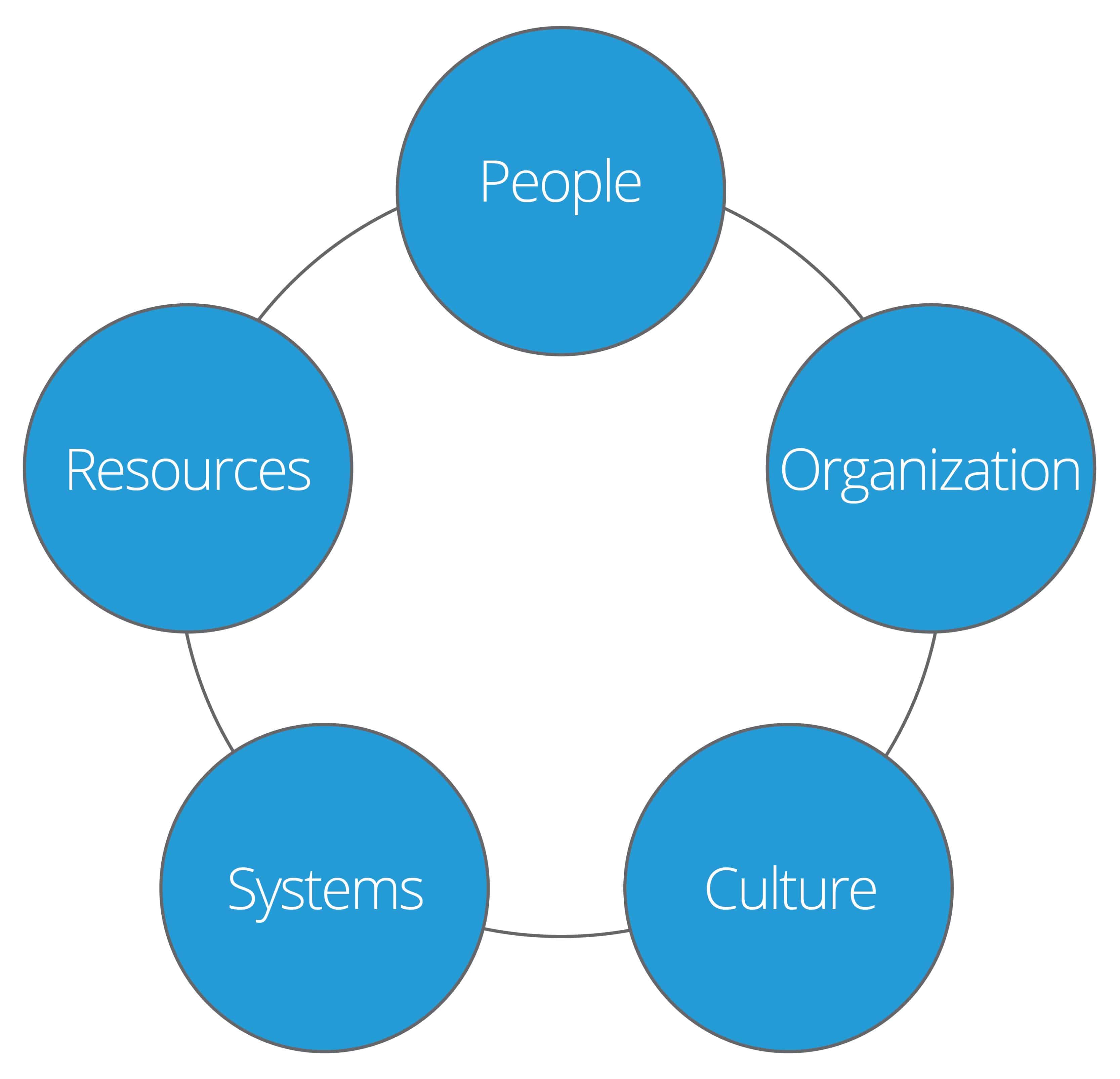
McKinsey 7S Framework
The McKinsey 7S framework is an organizational tool developed at the McKinsey & Company consulting firm in the 1980s, by Robert H. Waterman and Tom Peters. The framework can be used in many ways, including to determine how well an organization is prepared to change in order to implement a strategy.
Here are the 7Ss:
- Strategy: What needs to to be implemented
- Structure: The chain of command
- Systems: The tools used to perform tasks and complete processes
- Skills: What employees can do
- Style: How the leaders lead
- Staff: The employees
- Shared Values: The core values, expressed through the corporate culture
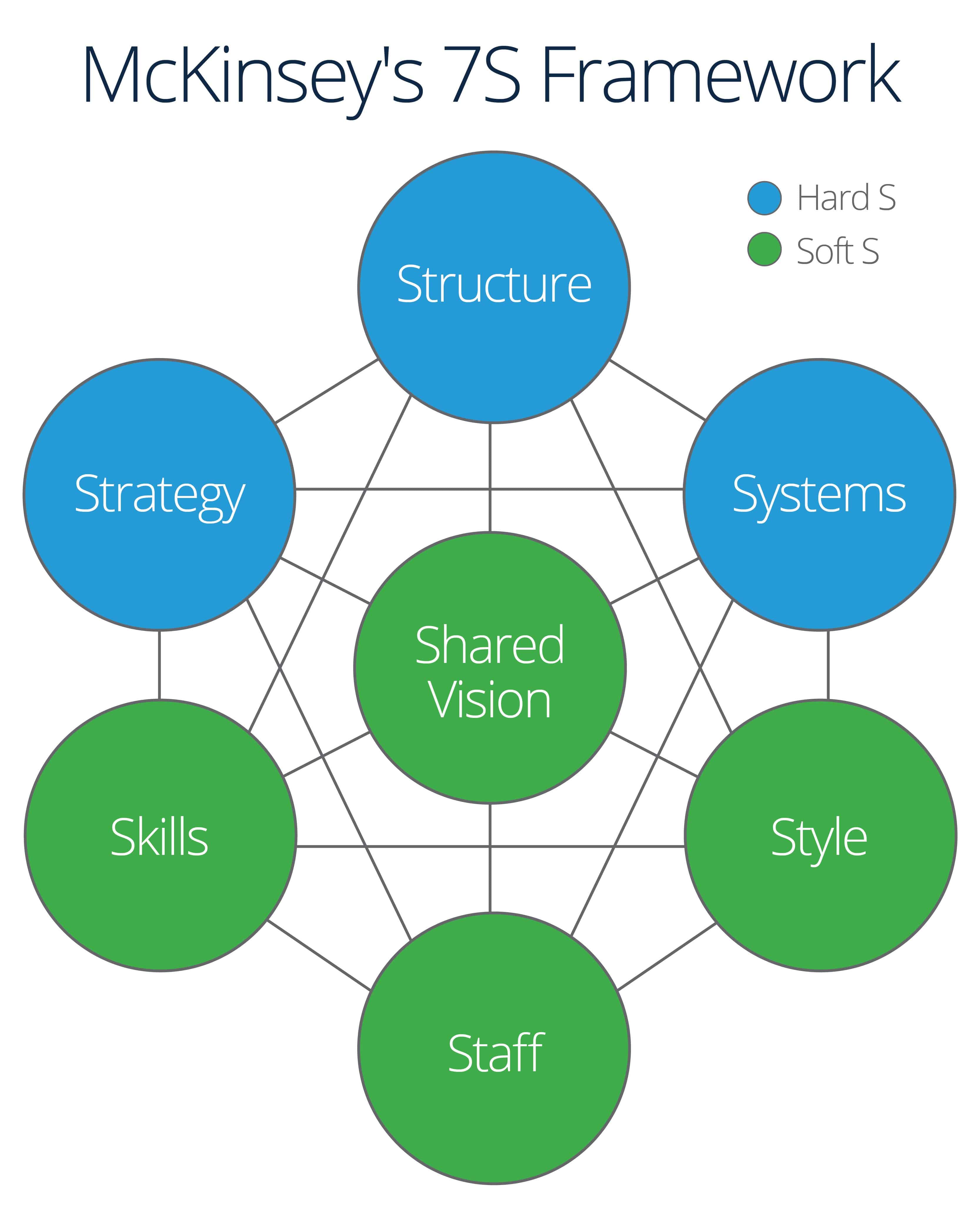
These can be divided into the hard Ss (Strategy, Structure, Systems), which are tangible, and the soft Ss (Skills, Style, Staff, Shared Values), which are intangible. In order to ensure smooth implementation, align each of these categories.
Examples of Successful and Unsuccessful Implementation Strategies
As previously mentioned, because strategy formulation, implementation, and execution are intertwined, it may difficult to know which phase is the cause of strategic failure. Here are some quick examples of success and failure where implementation is key.
Wal-Mart: The corporation became the retail giant they are by having low prices. They made lower margins by having high volume. In order to do that, they implemented a supply chain strategy that reduced operating costs. As they grew, their strategy was to use their size as a bargaining chip with suppliers to get even lower prices.
J.C. Penney: Penney’s was a major retailer in the U.S. for many years, but when the landscape changed, they kept doing the same things. When the company finally brought in new leadership in 2011, they implemented a strategy that eliminated coupons that customers used and lowered their regular prices. They also changed their retail mix. When sales began to fall, they maintained their implemented strategy without adjusting. If they had taken advantage of the data from strategic evaluations and had responded appropriately, they might have been able to salvage the parts of their strategy that were working.
Apple: In the late 1990s, Apple was close to going out of business. They had many products that didn’t sell. When Steve Jobs returned, he implemented a strategy that reduced the number of products, and worked to develop new ones. This approach eventually led to the invention of the iPod. The iPod was not the first MP3 player, but it was the first to catch on because of its ease of use and storage capacity. This, in essence, was an application of the Blue Ocean theory: Apple found a market segment that wasn’t very competitive, and created a product that was better than what was available. For a long time, Apple was the dominant player in that market segment.
Google: While Google is successful in most ventures (search, email, maps), they have had some notable stumbles. One is Google Glass, the company’s wearable computer. While the idea was good, the device was very expensive, was not easy to use, there were concerns about privacy, and was an unattractive pair of glasses. Mostly, there was no real compelling reason to use it. Google Glass was a failed application of the Blue Ocean theory, and also another failure to adapt to data from strategic evaluations.
Strategic Implementation without Disruption
Strategic implementation can involve the restructuring of reporting relationships: adding, deleting, or updating processes, or even layoffs. This process can be painful for employees, and can cause problems when it’s time to execute strategy.
Restructuring can be expensive, and the new structure can create issues as troublesome as those you are trying to solve. Employes have to adapt to the new structure and may be dissatisfied. As a result, a lot of tacit institutional knowledge can be lost as people get shuffled around or worse, leave the company. Restructuring may also result in maintaining legacy systems until they can be phased out, which causes unnecessary expense. Additionally, some people won't be able to fully focus on the new strategy while they keep legacy systems running.
It's far less disruptive to choose an organizational design that’s flexible and can be adapted without major conflicts, and then formulate strategies that can be easily implemented.
Robert S. Kaplan and David P. Norton recommend the balanced scorecard framework, which they co-created in the 1990s. They believe that this framework will minimize the need to go through disruptive restructuring when new strategies change due to the following reasons:
- It focuses on the strategic agenda of the organization.
- It recommends monitoring a small number of data points.
- It looks at both financial and non-financial data.
The implementation of this framework is beyond the scope of this article, but you can read an explanation of its benefits via the Harvard Business Review .
Sometimes disruptive restructuring is necessary. If it can’t be avoided, here are some steps to make it more manageable:
- Break the strategy into smaller chunks, so the disruption is spread over a longer time frame.
- Communicate directly to affected employees. Explain why the changes are needed, and retrain them to adapt to the new structure.
- Use a version of the strategic evaluation process that focuses on the affected employees, have them report their on satisfaction levels, and adjust the strategy based on that feedback to lessen the impacts.
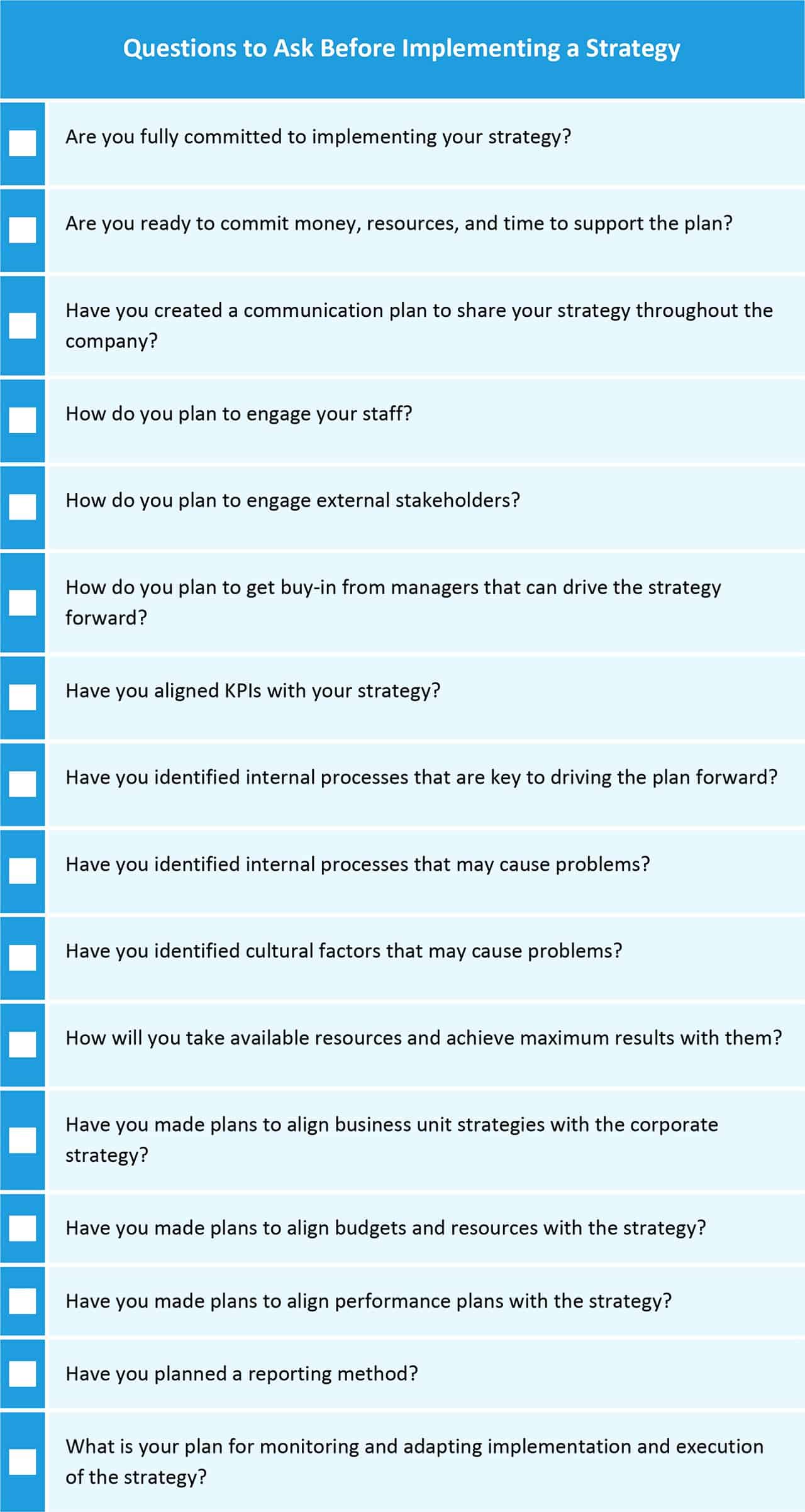
Download Checklist Here
Improve Strategic Implementation with Work Management in Smartsheet
Empower your people to go above and beyond with a flexible platform designed to match the needs of your team — and adapt as those needs change.
The Smartsheet platform makes it easy to plan, capture, manage, and report on work from anywhere, helping your team be more effective and get more done. Report on key metrics and get real-time visibility into work as it happens with roll-up reports, dashboards, and automated workflows built to keep your team connected and informed.
When teams have clarity into the work getting done, there’s no telling how much more they can accomplish in the same amount of time. Try Smartsheet for free, today.
Discover why over 90% of Fortune 100 companies trust Smartsheet to get work done.
- Business Essentials
- Leadership & Management
- Credential of Leadership, Impact, and Management in Business (CLIMB)
- Entrepreneurship & Innovation
- *New* Digital Transformation
- Finance & Accounting
- Business in Society
- For Organizations
- Support Portal
- Media Coverage
- Founding Donors
- Leadership Team

- Harvard Business School →
- HBS Online →
- Business Insights →
Business Insights
Harvard Business School Online's Business Insights Blog provides the career insights you need to achieve your goals and gain confidence in your business skills.
- Career Development
- Communication
- Decision-Making
- Earning Your MBA
- Negotiation
- News & Events
- Productivity
- Staff Spotlight
- Student Profiles
- Work-Life Balance
- Alternative Investments
- Business Analytics
- Business Strategy
- Business and Climate Change
- Design Thinking and Innovation
- Digital Marketing Strategy
- Disruptive Strategy
- Economics for Managers
- Entrepreneurship Essentials
- Financial Accounting
- Global Business
- Launching Tech Ventures
- Leadership Principles
- Leadership, Ethics, and Corporate Accountability
- Leading with Finance
- Management Essentials
- Negotiation Mastery
- Organizational Leadership
- Power and Influence for Positive Impact
- Strategy Execution
- Sustainable Business Strategy
- Sustainable Investing
- Winning with Digital Platforms
6 Tips for Transitioning from Strategy Formulation to Implementation

- 17 Nov 2022
Strategy formulation is key to a successful business, but it's only effective when implemented correctly. Some professionals are experienced in developing comprehensive business plans, while others are well-versed in execution —more commonly known as "thinkers" versus "doers."
A balanced combination of both is an invaluable asset to any business. If you're struggling to bring your business strategy across the finish line, here are tips for transitioning from strategy formulation to implementation and a deeper understanding of why it's essential to your company's long-term success.
Access your free e-book today.
Formulating a Successful Strategy
Developing an effective strategy requires in-depth knowledge, critical thinking, and careful planning. While several frameworks can help set the foundation, Harvard Business School Online's Business Strategy course uses the value stick.
The value stick is a visual representation of value-based strategy and can help you formulate a business model that factors in pricing, product positioning, and vendor management. Value-based strategy relies on customers' perceived value of the products or services being sold and determines the organization's prices, costs, and supplier strategy.

Some key terms for formulating a value-based strategy include:
- Willingness to pay (WTP): The price customers are willing to pay for a product or service. The margin between a customer's WTP and the actual price is deemed "customer delight," or customers' perceived received value.
- Price: The price the product is sold for. The margin between the price and cost is the firm margin, or the money the business makes.
- Cost: The cost of manufacturing the product.
- Willingness to sell (WTS): The lowest price a supplier is willing to accept for its services. The margin between WTS and cost is called "supplier surplus" or "supplier delight"—the value suppliers believe they're receiving.
This is just one framework for formulating a successful strategy. You can use similar tools, but the best option will always depend on your company's strategic planning needs . To ensure you're on the right path to an effective business strategy, here are six tips for formulating and implementing successfully.
6 Tips For Transitioning from Formulation to Implementation
After formulating a well-developed business strategy, it's time to execute, which is easier said than done. Strategy execution often poses several challenges that can be hard to overcome.
According to the HBS Online course Business Strategy , there are three characteristics of strategy implementation that make the process difficult for many companies:
- Boring: Strategy tends to be exciting; implementation, by comparison, can be rather mundane
- Time-consuming: The best strategies typically require years to implement effectively
- Detail-oriented: Good strategy implementation requires an attention to detail many managers don't have
To prevent these obstacles and ensure a smooth transition from formulation to successful implementation, here's an overview of what you can do to set your business strategy up for success .
1. Set Clear Goals
A simple and effective way to transition from formulation to execution is to set clear strategic goals . Strategic goals are measurable, actionable objectives that align with an organization's purpose and long-term vision. These goals ensure that individuals implementing the strategy have clear guidelines on how to define successful execution.
“When we set goals, we like to imagine a bright future with our business succeeding,” says HBS Professor Robert Simons in Strategy Execution . “But to identify your critical performance variables, you need to engage in an uncomfortable exercise and consider what can cause your strategy to fail.”
Planning in advance and identifying possible weaknesses in your strategy can help you achieve these business goals and objectives without additional roadblocks.
2. Create a Value Map
A value map is a visual tool that helps organizations determine the needs, pain points, or desires its products or services can solve or fulfill for potential customers. It's a tool that illustrates a business's potential value drivers, the factors that influence customers' willingness to pay for a product or service. Identifying and mapping value drivers can be used to formulate an organization's value proposition and key differentiators.
According to HBS Online's Business Strategy course, there are five steps to creating an effective value map:
- Identify value drivers: Determine 10 purchasing criteria customers use when choosing between your product and competing products.
- Rank value drivers: Rank those 10 criteria from most to least important.
- Rate your company's performance: For each value driver, rate how your company is performing from a score of one (poor) to five (excellent).
- Rate your competitors' performance: Repeat this process for two or three of your main competitors.
- Review your value map: Ask yourself if your findings accurately reflect the market's competitive situation, your company's strengths and weaknesses, and if there are actionable next steps to mend any competitive gaps.

By creating a value map, you can review your business's performance and discover new opportunities to improve your position in the market. A value map can also rank how well your company is attracting and maintaining talent compared to competitors.
3. Strengthen Important Value Drivers
Once you've identified your key value drivers, the next step of execution is to strengthen them. Yet, it's important to focus on strengthening the most important ones rather than all of them.
"If you strive to be exceptional everywhere and spread resources evenly across all your value drivers, you end up being mediocre throughout," says Harvard Business School Professor Felix Oberholzer-Gee, who teaches Business Strategy .
Once you've identified the most important value drivers, strengthening them requires generating creative ideas . Since enhancing value drivers can be a relatively vague task, creativity provides ideas and direction. Don't be afraid to think outside the box, take risks, or even fail. Through experimentation and testing, new ideas can strengthen your value drivers and propel your business forward.
4. Create a Plan For Evolving Your Value Proposition
A value proposition is a short statement explaining the value your company provides and how your product or services differ from competitors. As the business landscape and market shift, so must your value proposition.
Competitors often become imitators or substitutes, which can cannibalize your revenue. To stay on top, your strategy—including your value drivers and value proposition—will have to evolve continually.
5. Delegate Work Effectively
Successful strategy implementation can be an overwhelming, multi-step process. It's important for managers to delegate effectively . By assigning tasks to other team members, leadership can spend more time focusing on bigger picture elements and:
- Engage other team members
- Share core business values
- Encourage strategy buy-in
- Win together and boost team morale
6. Continue to Review Performance
While these tools can be helpful for any strategy implementation, they don’t guarantee success without constant review and oversight. A successful strategic plan that drives value for a business and its customers requires continuous performance reviews and improvements.
One factor of strategy implementation to review is your employees. According to Strategy Execution , it can be beneficial in some cases to use ranking systems when reviewing employee performance to ensure your strategic initiatives receive the support needed to succeed long term.
“Ranking systems have really good features that managers can use to stimulate performance,” says HBS Professor Susanna Gallani in Strategy Execution . For example, employees who are highly motivated by personal achievement often thrive as a result of ranking systems.
It’s also important to continuously review your strategy, even after implementation. To ensure you get the most out of this review process, consider setting up a standardized operating procedure (SOP) for a designated task owner to run regularly to analyze and determine if an update is necessary. This can help you avoid common pitfalls of business strategy failures.

Why Business Strategy Formulation and Execution Are Important
Business strategy is an essential component of long-term growth and success. It offers value to customers, encouragement to key stakeholders, purpose for your company initiatives, and direction to your team. Yet, formulation only gets you so far.
Don't lose momentum during the implementation phase—ensure all your hard work pays off. With the right framework, you can create value for your customers and implement a frictionless strategy to achieve outstanding financial results.
Are you interested in learning about strategy implementation? Explore Business Strategy and Strategy Execution , two of our online strategy courses , to develop your strategic planning and implementation skills. To determine which strategy course is right for you, download our free flowchart .
This post was updated on November 3, 2023. It was originally published on November 17, 2022.

About the Author

Strategy implementation plan template

What is a Strategy implementation plan?
A strategy implementation plan is a detailed plan that outlines how an organization will execute its strategic plan or business strategy. It includes specific action steps, timelines, and responsibilities that are necessary to achieve the strategic objectives of the organization. The purpose of a strategy implementation plan is to provide a clear roadmap for implementing the strategies and tactics identified in the strategic plan. It ensures that the resources, processes, and structures required to achieve the strategic objectives are in place, and that everyone in the organization understands their role in executing the plan.
What's included in this Strategy implementation plan template?
- 3 focus areas
- 6 objectives
Each focus area has its own objectives, projects, and KPIs to ensure that the strategy is comprehensive and effective.
Who is the Strategy implementation plan template for?
The strategy implementation plan template is for teams and organizations of all sizes and industries. Whether you are creating a plan for a small business or a large corporation, this template will help you create a plan that can be tailored to your specific needs.
1. Define clear examples of your focus areas
Focus areas are the main goals and objectives of your strategy. These can include improving customer satisfaction, enhancing team collaboration, increasing customer base, and more. Defining these focus areas will help you determine which objectives and actions are needed to achieve success.
2. Think about the objectives that could fall under that focus area
Objectives are the specific goals that need to be achieved in order to reach each focus area. These can include increasing customer loyalty, reducing customer wait time, and more. By defining clear objectives, you can ensure that you are working towards the right goals.
3. Set measurable targets (KPIs) to tackle the objective
Key Performance Indicators (KPIs) are measurable targets that are used to track progress towards the objectives. These KPIs can be anything from customer knowledge retention to average wait time to website visitors. By setting measurable targets, you can ensure that you are on track to achieve your goals. An example of a KPI for the focus area of Improve customer satisfaction could be: Increase customer knowledge retention from 30% to 75%.
4. Implement related projects to achieve the KPIs
Projects, or actions, are the specific tasks that need to be completed in order to achieve the objectives. These can include increasing customer education, streamlining customer service process, launching online advertising campaigns, and more. By implementing related projects, you can ensure that your strategy is being implemented correctly.
5. Utilize Cascade Strategy Execution Platform to see faster results from your strategy
Cascade Strategy Execution Platform is a tool designed to help teams and organizations implement their strategies quickly and efficiently. It automatically tracks progress against KPIs and provides real-time insights into performance. With Cascade, teams can ensure that their strategies are implemented quickly and effectively.

Strategy Implementation Plan

In order to know how to properly implement a strategy either for your business or personal endeavor, you must have a plan first. In there, you are going to make an outline and provide specific details so you will be guided eventually. Every business owner or company manager creates a comprehensive strategic implementation plan that will help them for a better flow of execution of their policies and proposed activities.
12+ Strategy Implementation Plan Examples
1. transport strategy implementation plan.
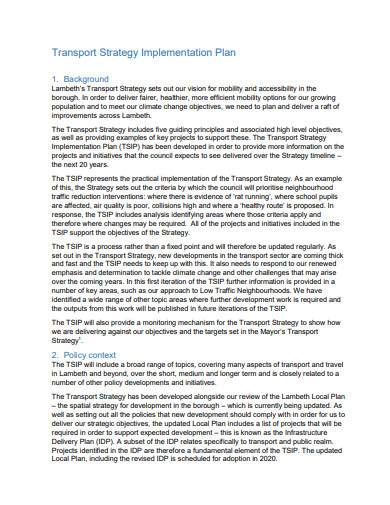
2. Strategy Implementation Plan
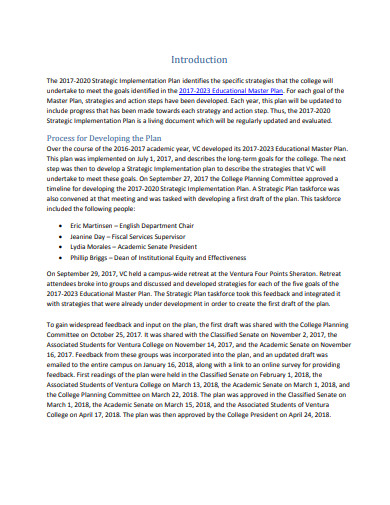
3. Basic Strategy Implementation Plan
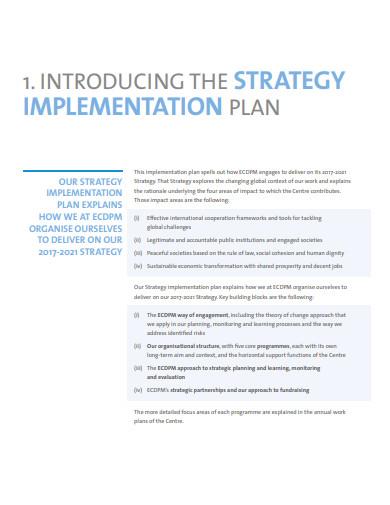
4. Strategy Implementation Action Plan
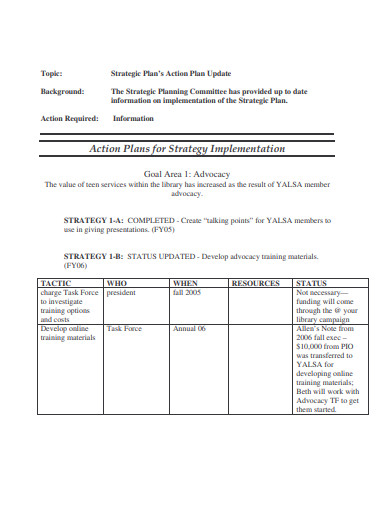
Size: 85 KB
5. Strategy Implementation Work Plan
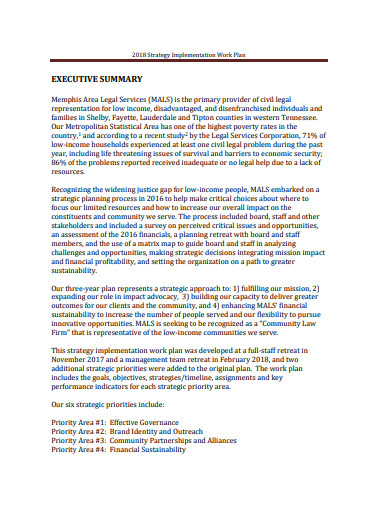
Size: 191 KB
6. Strategy Implementation Action Plan Example
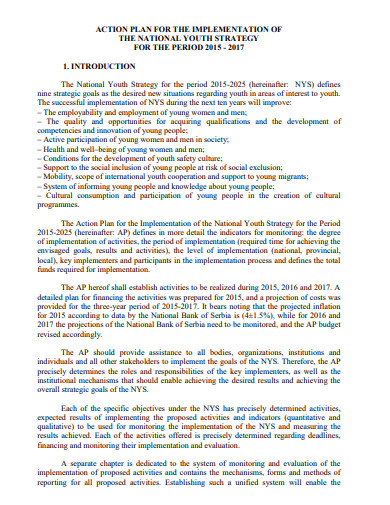
7. Housing Strategy Implementation Plan

Size: 95 KB
8. Sample Strategy Implementation Plan
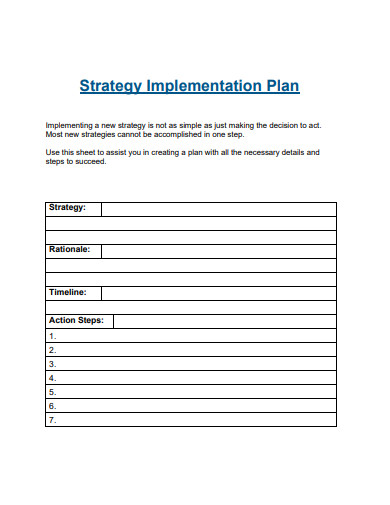
Size: 13 KB
9. Engagement Strategy Implementation Plan
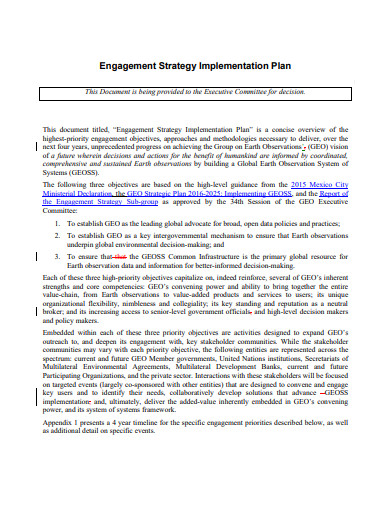
Size: 449 KB
10. Economic Development Strategy Implementation Plan
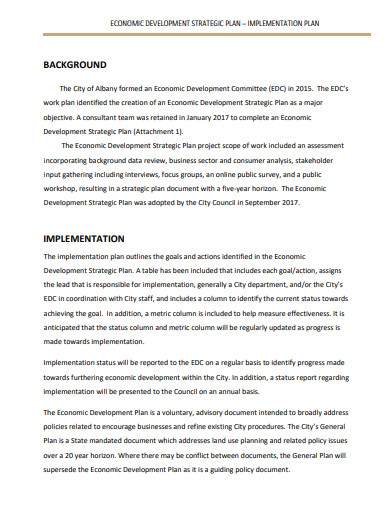
Size: 353 KB
11. Housing Strategy Implementation Plan Example
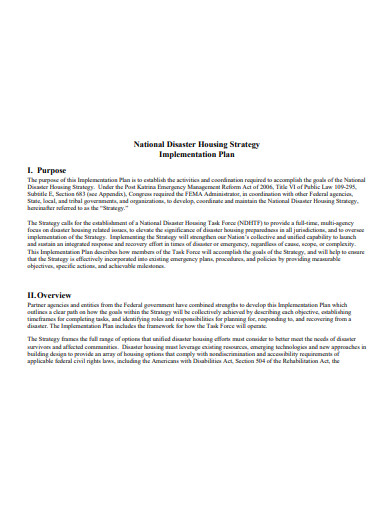
Size: 166 KB
12. Basic Strategy Implementation Action Plan
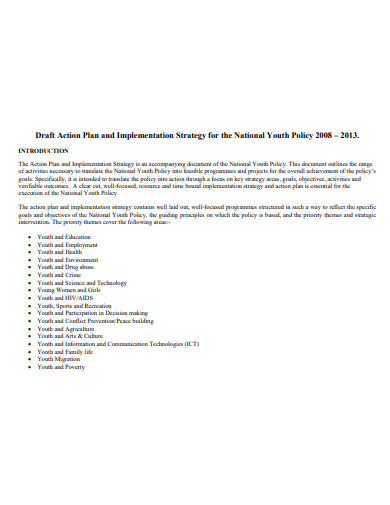
Size: 73 KB
13. Strategy Implementation Plan in DOC
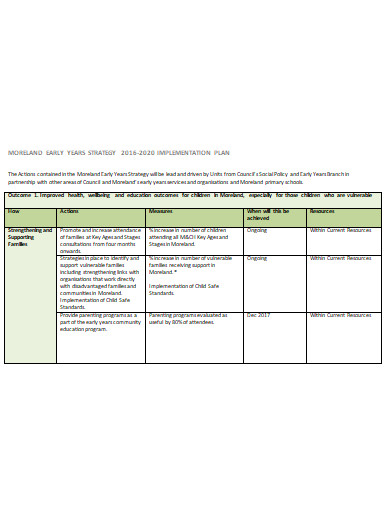
Size: 16 KB
What is a Strategic Implementation Plan?
A Strategic Implementation Plan (SIP) is a type of document that shows the list of activities, resources, roles and responsibilities and the budget with a corresponding execution plan . You can only consider a strategic plan “implemented” when you already met the requirements needed, and “executed” when you already took an action in connection to its purpose. In writing a strategic implementation plan, you must consider the questions who, what, where, when, why, and how.
What can you get from making SIP?
– A strategic plan guides you in the direction of where your business must really go.
– Allows you to provide full coordination of the activities and objectives.
– Helps you to make decisions on how you are going to accomplish your goals in terms of resources and budget.
The Stages of Strategic Planning
Every implementation would require undergoing different phases before it will be executed to the public. Here are the following stages that you may follow when making a strategic plan.
- Analysis and evaluation – evaluation of the internal and external influences of an organization
- Strategy articulation – development of organizational plans
- Plan-based action – transformation of organizational plans into action
- Appraisal and refinement – evaluation of the performance
How to Implement a Strategic Plan?
- Determine the tactics used by your competitors and the demand of your consumers.
- Secure a SWOT Analysis (Strengths, Weaknesses, Opportunities and Threats)
- Determine the steps you need to implement in fulfilling your mission.
- Set specific goals.
- Use your objectives to set for the development of your plan.
- Write an organizational structure and your planned budget.
- Evaluate if your objectives are met.
- Determine the needs of your customers.
- Assess your competitors
- Think of what else you need in order to achieve your goals.
Do we need to follow the exact details of the strategic plan?
Yes, but you also have the option to make some improvements to make your strategic plan look better.
Do I need a strategic plan to go on with my business or is it okay if I do not have one?
Every business needs a strategic plan for it allows you to be guided on the right procedures to take.
Is there a need to assess the implementation of your strategic plan?
Yes. The assessment will tell you how effective your plan is and if it is being followed accordingly. This will also give you an idea of what can be the possible struggles that you will be facing in the future.
Strategic implementation plan is very crucial in making the flow of your business organized. So if you want to have a successful implementation of your policies and activities, provide yourself with a good strategic plan. It may take a lot of time and effort in forming the right structure of your plan, at least it would be able to bring you to your right destination. Make several revisions if you can to make a perfect outcome of your plan.

Text prompt
- Instructive
- Professional
Create a study plan for final exams in high school
Develop a project timeline for a middle school science fair.
- Business Plan for Investors
- Bank/SBA Business Plan
- Operational/Strategic Planning Services
- L1 Visa Business Plan
- E1 Treaty Trader Visa Business Plan
- E2 Treaty Investor Visa Business Plan
- EB-1 Business Plan
- EB-2 NIW Business Plan
- EB-5 Business Plan
- Innovator Founder Visa Business Plan
- Start-Up Visa Business Plan
- Expansion Worker Visa Business Plan
- Manitoba MPNP Visa Business Plan
- Nova Scotia NSNP Visa Business Plan
- British Columbia BC PNP Visa Business Plan
- Self-Employed Visa Business Plan
- OINP Entrepreneur Stream Business Plan
- LMIA Owner Operator Business Plan
- ICT Work Permit Business Plan
- LMIA Mobility Program – C11 Entrepreneur Business Plan
- USMCA (ex-NAFTA) Business Plan
- Franchise Business Plan
- Landlord business plan
- Nonprofit Start-Up Business Plan
- USDA Business Plan
- Cannabis business plan
- Ecommerce business plan
- Online boutique business plan
- Mobile application business plan
- Daycare business plan
- Restaurant business plan
- Food delivery business plan
- Real estate business plan
- Business Continuity Plan
- Pitch Deck Consulting Services
- Financial Due Diligence Services
- ICO whitepaper
- ICO consulting services
- Confidential Information Memorandum
- Private Placement Memorandum
- Feasibility study
- Fractional CFO
- How it works
- Business Plan Examples
The Strategy of Business Plan with Implementation Summary
MAR.27, 2015

The business plan is written and ready for implementation. Now what? As a guide for action, the strategy and implementation summary in business plan sets out the strategies for business startup and continuity, and presents the operational financial plan. Planning and taking action are two very different activities. Once the entrepreneur begins implementing the business in the real world, challenges are sure to arise.
The strategy and implementation summary in the business plan section of the business plan identifies the path the business intends on using to establish and grow the business. It includes strategies identifying how the business will maintain a competitive edge, market the company, grow sales, develop a network of contacts and customers, and so on. Milestones are established that include the budget for implementation of each step. However, entrepreneurs commonly encounter difficulties, which is why so many new businesses fail within the first five years after startup.

Planning for the Difficulties
Common difficulties business owners face and possible solutions include the following:
• Problems with development of products described in the strategy and implementation summary in business plan (reorganize to better support product development) • Difficulty hiring and retaining skilled personnel (try using a human resources consulting company) • Marketing efforts fail to produce desired results (revise the marketing plan ) • Funding for strategy implementation proves to be inadequate (re-evaluate financial needs, revise strategies, and/or seek new investors) • Entrepreneur discovers he or she needs to strengthen management skills (take advantage of workshops and assistance offered by organizations like the Small Business Administration and the Chamber of Commerce) • New and unexpected competitors enter the market (revise product and service differentiation or marketing strategy) • Lack of a solid network (begin networking online through social media and offline through community business organizations)
These are just a few of the problems entrepreneurs may face when starting a new business. A quality strategy and implementation summary in business plan addresses strategy and implementation by outlining the strategic assumptions, supported by market analysis. If the analysis is thorough, the entrepreneur conducted a SWOT analysis and included contingency planning. An entrepreneur may experience difficulties, but those difficulties should not be a surprise.
Business Plan Revisions
The final business plan should never be final. It needs regular review and assessment in light of the results of actions taken and the difficulties experienced to achieve business startup, smooth operations, and growth.
The business environment is dynamic which is why OGS Capital has a cadre of business professionals with real-world experience. The consultants are experts in writing business plans , including strategy and implementation summaries. They are also ready to assist entrepreneurs who need business plan revisions as a result of difficulties encountered during startup and early stage operation. Submit the online contact form to begin discussing options.
Download Sample From Here
OGSCapital’s team has assisted thousands of entrepreneurs with top-rate business plan development, consultancy and analysis. They’ve helped thousands of SME owners secure more than $1.5 billion in funding, and they can do the same for you.

Add comment
E-mail is already registered on the site. Please use the Login form or enter another .
You entered an incorrect username or password
Comments (0)
mentioned in the press:
Search the site:
OGScapital website is not supported for your current browser. Please use:

Sling is now Sling by Toast! Learn more
More Features

- Restaurants
- Get Started

Strategy Implementation: The Complete Guide For Small Businesses
- Business Growth & Management , Templates & Guides
Strategy implementation is one of those concepts that all small business owners and managers know they need to work on. The problem is that very few of those owners or managers understand how to get started — or how to proceed once they have.
That’s where the experts at Sling can help. We’ve created this complete strategy implementation guide for small businesses so that you don’t have to recreate the wheel. Follow these eight easy steps to implement any strategy — large or small — and reach your goals sooner.
What Is Strategy Implementation?
On the face of it, strategy implementation is fairly simple: it’s the process that translates general strategies into actionable plans for reaching your goals. But underneath the straightforward definition lies a maze of different variables and methods that make strategy implementation difficult for a business to achieve.
Strategy implementation is built on such essential elements as:
It also incorporates a big-picture view of your business as well as SWOT and environmental analyses and any relevant issues and objectives. Needless to say, there’s a lot to consider when working to implement a new strategy.
We’ve simplified the process by reducing it to its basic components so that it’s easier to understand and, ultimately, execute.
8 Steps For Strategy Implementation
1) appoint a visible leader.

Every project needs a visible leader — strategy implementation is no different. For a small business, the leader will likely be the owner or manager. You can also delegate smaller strategy implementation projects to trusted employees who want to develop their skills and advance.
For large-scale strategy implementation, the leader should have access to a wide range of data, including but not limited to:
- Employee scheduling
- Existing business market
This gives the leader a complete picture of the business so he or she can make the most informed decisions possible.
For small-scale strategy implementation — like reorganizing the bar in a restaurant — less information is necessary. Throughout the rest of this article, we’ll assume strategy implementation on a grander scale (i.e., business-wide) so that you can get a feel for major organizational changes.
2) Create The Mission, Vision, And Values
Once you’ve appointed a leader, it’s time to create the mission, vision, and values of your strategy. The leader doesn’t have to do this all on their own. They can, of course, if the business is small enough. But even a mom-and-pop coffee shop can benefit from a diverse range of input at this point.
Don’t be afraid to meet with employees or talk with other business owners about creating a mission, vision, and values statement. That information will make the next few steps much easier.
3) Set Organizational Goals

Next, it’s time to set the organizational goals that pertain to this particular strategy implementation. Organizational goals are high-level objectives that apply to the business as a whole (e.g., market penetration, opening another location, new hiring practices).
These are usually items that a CEO, owner, or high-level manager is responsible (and accountable) for. Keep in mind that organizational goals will sometimes overlap with departmental and employee goals. It all depends on the size and scope of your business and your strategy.
4) Set Departmental Goals
When you have a complete view of your organizational goals, break them into smaller sub-goals and delegate responsibilities to each department.
For example, if one of your organizational goals is to reduce and simplify the processes in your restaurant , you might translate that into streamlining activity behind the bar. It then becomes a departmental goal assigned to the head bartender.
He or she would come up with a plan to make that goal a reality, and then either execute the plan personally or delegate the responsibility to another employee or team of employees.
5) Compose A Strategic Plan

Once you’ve established the mission, vision, and values statement and set organizational and departmental goals, it’s time to compose your strategic plan . Start by creating a written document that details the steps and processes your business needs to reach the goals you’ve set.
Be as detailed as possible, but also be willing to go back and change the plan if you see that something isn’t working or if someone has a better idea.
6) Analyze And Allocate The Resources
After you’ve composed your strategic plan, use that information to analyze and allocate any and all resources necessary to get the job done. Don’t forget to take into account:
All of these resources can have a dramatic effect on the success of your strategy implementation.
7) Assemble A Team And Go To Work

With your plans set and your resources dedicated to the task at hand, it’s time to assemble your team and go to work. Assign individual tasks and set deadlines to adhere to the timeline you’ve established in your strategic plan.
Once the project is underway, get everyone involved. While only a small team may be working on the actual implementation, success depends on getting everyone in your business engaged and working toward the same goal.
It’s also essential to hold employees accountable for their part of the plan so that they take ownership of their work and feel invested in the change. But don’t give individual employees too much power. If you do, you run the risk of them making changes that are contrary to your overall plan.
8) Take Advantage Of Performance Measurement Tools
Don’t let your strategy implementation continue too long without measuring its performance. That may involve an employee performance review , another SWOT analysis, a labor-cost review, or something completely different. Again, it all depends on your goals and the strategy implementation itself.

The tools you choose to gauge strategy implementation performance will be dictated, in large part, by the smaller departmental goals you’ve established.
If, for example, you’re trying to simplify the clock-in/clock-out procedure in your business, you would get a clearer picture of all the variables involved by incorporating a time-tracking suite of tools like Sling to measure performance. That way, you would know for sure if the changes you’re making are helping or hindering the process as a whole.
Your Strategy Isn’t Set In Stone
No plan is perfect, so don’t consider it set in stone. Once you’ve finalized everything and turned your team loose to implement the strategy, it’s time to observe, assess, and make changes if necessary.
Look for pieces of the plan — or the strategy itself — that aren’t working and tweak them so that they do. Sometimes, all it takes is a slight change to get back on the road to success.
For more free resources to help you manage your business better, organize and schedule your team, and track and calculate labor costs, visit GetSling.com today.
See Here For Last Updated Dates: Link
This content is for informational purposes and is not intended as legal, tax, HR, or any other professional advice. Please contact an attorney or other professional for specific advice.
Find the article useful? Share with others:

Related articles

What Organizational Strategy Is And Why Your Business Needs It
Organizational strategy isn’t just for big business anymore. Even a startup co...

15 Tips for Building a Stronger Restaurant Culture
Want to improve what your team members do, what they say, how they behave, and h...

How To Write Your Ideal Restaurant Mission Statement + 15 Inspiring Examples
Whether you run a one-person food cart, a small eatery with fewer than five empl...
Get started today
Schedule faster, communicate better, get things done.

Strategy Implementation Plan Template
Identify strategic objectives.
- 1 Lack of clarity in organizational goals
- 2 Limited resources for implementation
- 3 Resistance to change
- 4 Limited market data
- 5 Competitive pressures
Conduct a thorough market analysis
- 1 Customer surveys
- 2 Competitor analysis
- 3 Industry reports
- 4 Market research firms
- 5 Government data sources
Create an implementation schedule
Identify resources required for the implementation.
- 1 Limited budget
- 2 Resource allocation conflicts
- 3 Availability of skilled personnel
- 4 Technological limitations
- 5 Supply chain disruptions
Approval: Project Manager on resources allocation
- Identify resources required for the implementation Will be submitted
Develop performance measures
- 1 Identify relevant metrics
- 2 Establish baseline data
- 3 Set performance targets
- 4 Implement tracking systems
- 5 Monitor and report on performance
Identify risks and develop mitigation plans
- 1 Risk identification
- 2 Risk assessment
- 3 Risk prioritization
- 4 Mitigation strategy development
- 5 Risk monitoring
Create communication strategies
- 1 Employees
- 2 Customers
- 3 Investors
- 4 Suppliers
Approval: Director on communication strategies
- Create communication strategies Will be submitted
Set up a system to monitor and review progress
- 1 Establish key metrics
- 2 Implement tracking tools
- 3 Schedule regular review meetings
- 4 Analyze and report on progress
- 5 Identify and address deviations
Train employees on new strategies
- 1 Develop training materials
- 2 Schedule training sessions
- 3 Deliver training sessions
- 4 Assess training effectiveness
- 5 Provide ongoing support and guidance
Approval: HR Manager on employee training plan
- Train employees on new strategies Will be submitted
Implement the strategy
- 1 Resistance to change from employees
- 2 Technical difficulties
- 3 Lack of necessary resources
- 4 Competitive pressures
- 5 Legal or regulatory constraints
Establish control mechanisms
- 1 Define control criteria
- 2 Implement tracking systems
- 3 Analyze and report on deviations
- 4 Take corrective actions
- 5 Update control mechanisms as needed
Measure and monitor progress
- 1 Collect performance data
- 2 Analyze performance data
- 3 Generate progress reports
- 4 Communicate progress to stakeholders
- 5 Identify areas for improvement
Observe and analyse any resistance to change
- 1 Provide clear communication and explanation
- 2 Involve employees in decision-making
- 3 Offer incentives or rewards
- 4 Provide training and support
- 5 Address concerns and fears
Update strategy as per feedback
- 1 Analyze feedback data
- 2 Evaluate strategy effectiveness
- 3 Identify areas for improvement
- 4 Refine strategy objectives and action plans
- 5 Communicate strategy updates to stakeholders
Approval: CEO on strategy updates
- Update strategy as per feedback Will be submitted
Communicate changes to all stakeholders
Review and assess overall implementation success.
- 1 Analyze performance data
- 2 Evaluate achievement of strategic objectives
- 3 Identify lessons learned
- 4 Provide recommendations for future improvements
- 5 Generate final implementation assessment report
Take control of your workflows today.
More templates like this.

Build plans, manage results, & achieve more
Learn about the AchieveIt Difference vs other similar tools
We're more than just a software, we're a true partner
- Strategic Planning
- Business Transformation
- Enterprise PMO
- Project + Program Management
- Operational Planning + Execution
- Integrated Plan Management
- Federal Government
- State + Local Government
- Banks + Credit Unions
- Manufacturing
Best practices on strategy, planning, & execution
The leading community for strategy, planning, & execution leaders
Real-world examples of organizations that have trusted AchieveIt
Ready-to-use templates to take planning to the next level
Research-driven guides to help your strategy excel
Pre-recorded & upcoming webinars on everything strategy & planning
- *NEW!* Podcast 🎙️
- Strategic Execution
Key Elements of Successful Strategy Implementation and Execution
RELATED TAGS:
change management , goal setting , plan execution , Strategic Planning , strategy execution , Strategy implementation
A strategic plan often shimmers, at first, with the promise of success and progress. However, the road between intention and impact can be long and unpredictable. While strategic plans themselves outline the desired direction, they often lack the gears to propel the organization forward. The crucial missing piece lies in strategy implementation. Without a clear roadmap for translating lofty goals into actionable steps, even the most well-crafted plans risk gathering dust on a shelf.
What’s often overlooked, however, is the fact that an organization’s success rests heavily on its ability to implement decisions and execute processes efficiently, effectively, and consistently. At AchieveIt, we can help you bridge between strategy and execution, highlighting the pivotal elements that make for successful strategy implementation.

The Disconnect Between Strategy and Execution
For years, leaders have crafted strategies in PowerPoint slides and documents. But here’s the issue: many of these strategies never get implemented. The problem stems from unclear direction and lack of understanding across all levels of the organization.
The usual way of creating a strategy often overlooks how it will be carried out. Strategies can fail right at the start of implementation because stakeholders don’t get it, the market changes, or it’s just hard to turn big plans into everyday actions that the team can handle.
How Strategy Should Empower Execution
A successful strategy should be adaptable and evolving, creating a flexible environment for adaptability and alignment. It should help employees see how their work directly contributes to the overall strategic goals. Strategy shouldn’t just be a fixed document; it should change and stay relevant to today’s business landscape and future opportunities.
Clear, understandable strategies are key, ensuring all employees can see how their tasks connect to the broader goals. When strategic direction is unclear or complicated, it becomes much harder to execute efficiently.
Also read: Strategic Planning and Execution Trends for 2024 and Beyond
Align Jobs with Strategy
Using the Manifest Internal Alignment framework, jobs and teams should align directly with the boundaries and initiatives of the strategic plan. This means every job plays a strategic role, embodying the organization’s strategic direction in all its functions.
Recalibrating Organizational Structure
Leaders should periodically recalibrate their organizational structures to reflect the current strategic priorities. This realignment requires more than just adjusting reporting lines; it demands a close analysis of roles, responsibilities, and processes to ensure they are facilitating, not hindering, strategic execution.
Inspire Employee Buy-In
Going beyond just introducing a new strategy, leaders need to motivate and engage employees. This means crafting a clear story that explains the strategy’s significance, relevance, and potential results. Without this, the strategic plan becomes just another item on a checklist, lacking the enthusiasm and dedication needed for effective implementation.
Communicating with Clarity and Passion
Effective communication is crucial to connect strategic plans with their execution. Leaders must clearly communicate the strategy, emphasizing key points across different channels. By reinforcing the organization’s dedication to its goals, leaders can inspire alignment and drive successful implementation.
Cultivate Accountability
Merely outlining strategic objectives is not enough. There must be clear lines of accountability to ensure that strategic initiatives are tracked, managed, and adjusted as needed. Without a system to hold individuals and teams accountable, strategic plans risk becoming a repository for unfulfilled aspirations.
Transparency in Monitoring Progress
Organizations that focus on transparency by openly sharing insights into their strategic performance build trust and encourage collective ownership among stakeholders. Giving regular updates on strategic progress helps keep everyone accountable, celebrate successes, and learn from challenges.
Also read: You Shouldn’t Spend More Than a Few Days on Your Strategic Reporting
Implement Regular Progress Tracking
Strategic Implementation needs to be an ongoing process, where the organization keeps an eye on progress and makes adjustments as required. This involves not only setting Key Performance Indicators (KPIs) aligned with strategic goals but also using data-driven insights to improve the execution method continuously. By promoting adaptability and learning from results, organizations can ensure successful implementation of strategic initiatives and achieve desired outcomes.
Adapting to New Realities
Market and internal dynamics are in a constant state of flux, requiring organizations to be agile and responsive. Regular progress tracking should involve assessing how important strategic objectives are in light of new information. Adjusting the strategic plan and execution method accordingly is crucial to stay competitive in the ever-changing business environment.
Avoid Common Pitfalls in Implementation
Imagine pouring your heart and soul into crafting a brilliant strategic plan, only to see it gather dust on a shelf. Unfortunately, this happens more often than not. The difference between a well-written plan and a thriving business lies in successful implementation.
Below are some of the most common roadblocks that derail strategic execution and equip you with practical strategies to bridge the gap between vision and reality.
1. The Ownership Gap:
- The Problem: When a plan feels like someone else’s project, people lack the motivation to translate it into action.
- The Fix: Foster a sense of ownership. Involve employees at all levels in the planning process, encouraging their ideas and expertise. Communicate how each individual contributes to the bigger picture.
2. The Communication Chasm:
- The Problem: Employees left in the dark about the plan can’t contribute or feel disconnected from the company’s goals.
- The Fix: Prioritize clear and consistent communication. Utilize various channels to explain the strategy, its purpose, and individual roles. Regular updates and open forums keep everyone informed and engaged.
- Getting lost in the Daily Grind:
- The Problem: Day-to-day operations can easily overshadow long-term goals. Managers can become reactive, neglecting the strategic plan.
- The Fix: Schedule regular check-ins to review progress and ensure alignment with the strategic plan. Integrate strategic objectives into daily tasks and performance metrics.
4. Stuck in the Strategy Silo:
- The Problem: The strategic plan exists in isolation, disconnected from the regular management process.
- The Fix: Embed the strategic plan into your core business processes. Use it to guide decision-making, resource allocation, and performance evaluations.
5. The Overwhelm Overload:
- The Problem: An ambitious plan with too many goals and actions leads to paralysis. Employees become unsure where to begin.
- The Fix: Prioritization is key. Focus on a set of high-impact objectives and eliminate non-critical actions. Ensure goals are clear, measurable, and achievable.
6. The Meaningless Mission Statement:
- The Problem: Generic vision and mission statements lack substance and fail to inspire employee buy-in.
- The Fix: Craft a compelling strategic narrative that resonates with your employees. Translate abstract concepts into actionable steps.
7. The Annual Retreat Syndrome:
- The Problem: Strategy discussions are confined to yearly retreats, lacking ongoing focus and adaptation.
- The Fix: Integrate strategic thinking into your company culture. Regularly revisit and refine your plan as circumstances evolve. Encourage continuous learning and adaptation.
8. Planning for the Sake of Planning:
- The Problem: The emphasis is only on making the plan, overlooking the vital implementation stage.
- The Fix: Create a clear implementation roadmap right from the start. Assign resources, set timelines, and put in place accountability measures.
9. The Progress Paradox:
- The Problem: Without tracking progress, it’s impossible to measure success or identify areas for improvement.
- The Fix: Set specific metrics that match your strategic goals. Regularly track progress, tweak strategies when necessary, and recognize milestones and accomplishments.
10. The Accountability Abyss:
- The Problem: Lack of accountability leads to complacency and slows progress.
- The Fix: Assign clear ownership for each strategic initiative. Implement regular performance reviews and provide constructive feedback to keep everyone accountable for their contributions.
11. The Empowerment Enigma:
- The Problem: Accountability without empowerment leads to frustration as employees may not have the necessary resources or authority to reach their goals.
- The Fix: Provide employees with tools, training, and decision-making power required to carry out their tasks. Cultivate an environment promoting initiative and recognizing calculated risks.
Also read: Owning Up: Common Mistakes in Leadership and Strategy
At the end of the day, successful strategy implementation requires a systematic and holistic approach that begins with ensuring that strategies are clear and easy to understand, jobs are intricately linked with strategic objectives, leadership inspires employee buy-in, accountability is enforced, and progress is tracked and adjusted regularly.
It’s the combination of these elements that turn a strategic plan from just an idea into a practical guide for success. Organizations need to strengthen each of these pillars to make sure their strategies lead to real and lasting success.
Related Posts

The Human Element in Strategy Implementation: How to Motivate Your Team

How to Leverage Tools for Seamless Strategy Execution

3 Key Change Management Strategies for 2024
Hear directly from our awesome customers
See first-hand why the world's best leaders use AchieveIt
See AchieveIt in action
Stay in the know. Join our community of subscribers.
Subscribe for plan execution content sent directly to your inbox.
Don't bother with copy and paste.
Get this complete sample business plan as a free text document.
Business Consulting Business Plan
Start your own business consulting business plan
Growth Management and Strategies
Executive summary executive summary is a brief introduction to your business plan. it describes your business, the problem that it solves, your target market, and financial highlights.">.
Growth Management and Strategies (GMS) is an ambitious innovative new company that is attempting to turn the small business consulting business on its head. With an experienced consultant at the helm as President, GMS intends to grow at more than 50% per year through solid customer service, a great sales plan, proven competitive strategies, and a group of people that bring dynamic energy to the company and the sales process.
The goal for this plan is financial: GMS needs a Small Business Adminstration (SBA) loan, and this document is one step in the process. It is also a road map for the company. The document gives all present and future employees, as well as the owner a sense of purpose that may exist without the business plan, but becomes more relevant after the business plan is written, reviewed, shared, and edited by all. It is a living document that will last far beyond the SBA loan purpose, or if that doesn’t occur, to bring an investor on board.
GMS’s financials are realistic, and based on very conservative sales figures relative to the industry as a whole. That is because one of the goals of GMS is to build the business one client at a time, and to serve each client as if it were the last. This is how loyalty is generated, and cultivated. Customer service is what GMS will do best, and is a large part of the company’s overall mission.
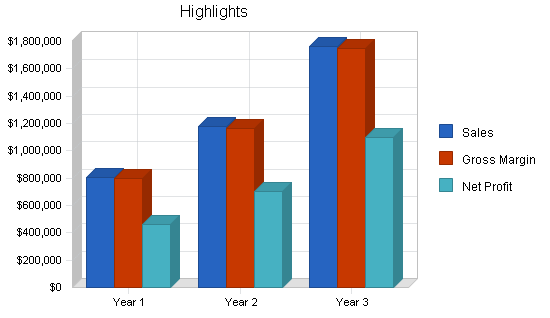
1.1 Objectives
The objectives for Growth Management and Strategies are:
- Gain access to an SBA loan upon start up.
- Grow the company from 2 employees in Year 1, to over 10 by Year 5.
- Increase revenue to over $3 million by Year 3.
- Increase client base by 450% in three years.
- Maintain job costing that keeps margins above 70%.
1.2 Mission
The company mission is to serve small business clients that are in need of logistical, technical, and business strategy services. All projects will be chosen based on the availability of human resources, and each individual employee will be given the respect of a contract worker, and will share in profits for each job. Politics have no place at Growth Management and Strategies, and to limit the affects of favoritism, the company will implement and clearly communicate a performance review policy that applies to those at the bottom as well as the top of the leadership ladder. Credit will be given to the person who performed and/or innovatively modified a project, and compensation will be both financial and in the form of commendation.
Growth Management and Strategies is a company that respects the needs and expectations of its employees and clients. If either is compromised, adjustments will be made so that the company culture may remain intact.
1.3 Keys to Success
Our keys to success are:
- To maintain client satisfaction of at least 90%.
- To keep overhead low.
- To ensure professional marketing and presentation of services.
- To provide an active and functional website.
See why 1.2 million entrepreneurs have written their business plans with LivePlan
Company summary company overview ) is an overview of the most important points about your company—your history, management team, location, mission statement and legal structure.">.
Growth Management and Strategies was established as a C corporation. The company’s headquarters are located in Boston, MA, near Copely Place. The company was established as a result of the efforts of its owner, Bill Dawson, and his experience in leading small businesses into prolonged periods of growth and innovation. Dawson worked for McKinsey before being hired away to Bain and Company. A Harvard graduate, Dawson spent hundreds of hours each week for nearly a year, slowly building the company to where it is now.
The company has had numerous successes this year, including one client that was purchased by a major multinational conglomerate, and another that experienced product sales growth of over 700% the first year.
2.1 Start-up Summary
This start-up summary table lists all the costs associated with establishing a lease, purchasing office equipment, and pulling together the other resources necessary to get the business off the ground. Furniture, LAN lines, and additional technology purchases are a must in order to properly communicate with clients, and to establish a website.
Other services included in the start-up summary are legal consulting fees, kept to a minimum thanks to resources provided by Nolo. Incorporation fees are included in the legal fees line item.
The free cash flow (cash balance) appearing in this start-up table is high relative to other small consulting businesses of its size. The owner is preoccupied with maintaining positive cash flow, and is risk averse enough to understand that during months in which contracts are not available, the corporation must sustain itself. With this said, planned debt leverage is low, therefore risk to the lender is relatively low as well.

2.2 Company Ownership
Growth Management and Strategies is wholly owned by Bill Dawson, and is classified as an LLC.
Growth Management and Strategies offers a variety of services to the small business client. Many of the services are customized for each client, and a bidding process is observed. The company also offers a traditional fixed rate sheet for its services.
Market Analysis Summary how to do a market analysis for your business plan.">
The target customer owns a small business, and is generally dissatisfied with the revenue that the business is generating, or is dissatisfied with the daily management of their business. The customer is likely to operate a business worth between $200K and $10 million, with growth rates of between 1-10%, or even a negative growth rate.
Market growth, that is, the predicted growth in the small business sector within the Boston/Cambridge Metro area is expected to be around 3% per year. This may increase due to additional SBA lending programs designed to match the strengths of research and faculty grant work with the needs of the market and small businesses willing to take new products to market. Regardless of the market growth, the company’s customer base is far more dependant upon service needs, and a solid reputation. Mr. Dawson is well respected within the community, and has built a number of relationships with high profile individuals, and is a frequent contributor to the business section of the Boston Herald.
The corresponding market analysis table below breaks the potential market down into tactical sub-markets.
4.1 Market Segmentation
The market is divided up by revenue in the initial analysis, although other factors are very significant. It is important that the client business is operating at about the same level as the general economic growth rate, or is underperforming. The need for a turnaround within the client company is necessary for Growth Management and Strategies’ expertise to become useful. The following are other differentiators:
- Debt of more than 30% yearly revenue.
- Free cash flow frequently in the negative, requiring deep pocket borrowing or investment.
- Long-term growth underperforming relative to competitors.
- Management discord and performance issues.
These are not the only differentiators used to determine the market potential for a client, they are simply a starting point for the sales team as they reach out to this group of small businesses, owners and investors.

4.2 Target Market Segment Strategy
The target market strategy involves isolating potential customers by revenue, then drilling down to very specific needs via the sales team’s needs analysis methodology.
The first tier customers, businesses with over $3 million in revenue, is more experienced in outsourcing and may find themselves more comfortable hiring Growth Management and Strategies on retainer. Strategically, a retainer helps maintain consistent cash flow, even if during some months these customers will require more services than what they have paid for that month. This issue will be addressed in the Personnel topic.
The second tier customers, those businesses operating at revenue levels of $501K – $3 million, typically are very excited to have moved out of the home office stage, and into a new level of stability. If they are self-funded, these businesses can be the most challenging to work with because they are often not willing to part with company shares, and don’t yet have a sense of what kind of marketing investment is necessary to grow a business at this stage. The company will serve these small businesses based on a bid cycle, and needs analysis.
The third tier customers are easier to identify, and more ubiquitous than the rest. These small businesses are operating on $200K – $500K in revenue, often are operating out of a home, and have a firm sense of their market and potential, yet have trouble executing their plans effectively, or following through on growth strategies that generate wealth. Again, the strategy is to provide these businesses with a short needs analysis, and focus on the quantity of such customers to maintain a solid revenue stream.
4.3 Service Business Analysis
This industry is split up between a variety of players, including small businesses advising small businesses, such as the case with Growth Management and Strategies, to large conglomerate multinational consulting firms that send in newbie MBAs and use their name recognition to convince their clients that every one of these MBAs will generate over $300K a year in value. Sometimes they do, but when they don’t, GMS plans to be there.
At the other end of the spectrum, there are a wide variety of mom and pop consulting firms owned by very talented people who simply don’t have the marketing resources or expertise to reach a broader spectrum of customer.
GMS is somewhere in between. With years of guerrilla marketing experience, and a long-term plan for success, Mr. Dawson is determined to build the company each client at a time, and to focus on a sales team that outperforms all the competitors.
GMS is planning to grow exponentially within the first two years, to over $2 million in consulting revenue. At this point the service business analysis will be re-evaluated from the outside in.
4.3.1 Competition and Buying Patterns
Typically small business clients will learn about the consulting services market through word-of-mouth experience passed on through a friend or contemporary. Still, outbound sales teams dominate this category, and the stronger your sales team and name recognition, the greater your odds of finding clients willing to place your company on retainer or accept your company’s bid. The most competitive players in this market tend to have some of the best sales teams in the industry, that is, people who know not only how to communicate the technical needs analysis in a non-technical way, but in addition, are able to follow through and execute on promises and provide accurate, industry specific information that is useful to the client even before the deal is made.
Price is also important, and operates on a complex tiered system that is dependant upon the effectiveness of a particular salesperson, the word-of-mouth (WOM) advertising already in the mind of the potential client, and the ability of the client to reform the way they think about their own business. The demands of turning a business around, or pushing it to the limits of its potential are in direct proportion to the price of each bid. GMS must be careful not to be lured into out bidding a competitor, only to find that the customer has no plans to modify their business plan, and are seeking a “magic bullet” that may or may not exist. Competition in this industry leads to frustration and burnout for many people, and it takes a strong sense of purpose to push the business beyond the realm of the high-intensity, low-return client.
Strategy and Implementation Summary
GMS will pursue a strategy in line with the experience of the owner, and implementation will be performance based and follow a clear path. Milestones are important to the implementation of this plan, and so is the vision and the will of the company’s owner, Mr. Dawson. The overall company strategy is tied very closely with the sales strategy, that is, with the front lines of the business. One of the biggest threats to any strategy is that they can become too high-minded, and not literal enough to translate into action. This will not be the case with GMS, a solid company that hires top talent and achieves it’s goals on time and on budget.
5.1 Competitive Edge
GMS has a significant competitive edge in the following areas:
- Customer service mobility – As a customer-centric firm, GMS offers no hold phone lines, same day email responses, and callbacks within one hour. In addition, the phone technology is set up in such a way as to provide salespeople with all databased information about the customer before they say “hello”.
- “Needs Analysis” service – Possibly the best competitive edge in an industry fraught with agressive outbound sales teams and your run of the mill ego-centric, customer alienating, consultants.
- A considerable network of contacts – Mr. Dawson is well connected in the area of general consulting, and his Harvard degree opens doors via simple bragging rights, and an extensive alumni network.
5.2 Marketing Strategy
GMS’s marketing strategy revolves around a three-tiered focus. At the top of pyramid one, imagine a customer service ideal. This ideal is also included in the competitive comparison.
Pyramid two is focused on the execution level of all sales efforts. Not just as a goal, but execution as a strategy for building a stronger focus and building on what has already been accomplished. There are many tactics available in this pyramid, and those details are available in the marketing plan upon request.
Pyramid three has at the top a team-centric company culture. Tactics revolve around building this culture from the ground up so that it rewards innovation and determination, and management shows no personal bias or favoritism except when a salesperson or consultant is outperforming the mean. Although this strategy appears to be an internal management goal or company summary object, it is highly relevant to marketing’s performance because without integrity standards and a consistent company culture, GMS’s marketing will feel disconnected and unsupported, and will suffer as a result. A more detailed breakdown of tactics and programs related to this strategy is available in the full marketing plan.
5.3 Sales Strategy
GMS plans to develop and train 5-6 new salespeople by year two. Upon start up, the primary sales contact will be Mr. Dawson, but this will change as the revenues increase, and the company is able to invest in human capital.
GMS has a sales strategy that focuses on an initial needs analysis. Once the results of the needs analysis has been forwarded or described over the phone to a potential client, the salesperson will ask for a personal interview, a chance to sit down and discuss specifics. At no time should this be perceived by the potential client as “pushy” or “agressive.”
The goal of this sales process is to get behind the numbers, and the business successes, to identify where the client’s needs lie. Once this is mapped out, GMS will decide how these problems can be best addressed, and will offer both a bid and some action points. If the client wants to use the action points to move forward on their own, this is very acceptable. GMS’s research has in fact shown that the clients that choose this path, often come back to seek additional information, and more often than not, accept the bid.
This strategy differs from the course often taken by large consulting firms in that the customer is not condescended to, or treated as if the knowledge isn’t right there in their own heads. Often, consulting companies will send a large ego to clean up a client’s mess, and find that the strategy backfires when the client only chooses to give the consultant the chance to bid. GMS’s sales strategy revolves around customer service and empowerment, not condescension and sales “closers.”
5.3.1 Sales Forecast
Sales forecast is based on the assumption that most of the revenue will be the result of consulting bids. The growth in retainer revenue is about 30% lower than the expected yearly growth in consulting bids of 80%/year. This may seem like an agressive number at first glance, but this is not a large company being discussed in this business plan. The smaller the company, often the larger the opportunity for exponential sales growth, and especially if the firm uses sound sales and marketing strategies to take share from the larger, less nimble consultancies.
The Needs Analysis service is listed only to highlight the fact that some outside information gathering firms/consultants will be used to compile the necessary information. This poses some risk because there are no costs associated with the Needs Analysis efforts. Nevertheless, GMS is confident that this product will set the company apart from the competition, and generate sales far in excess of the costs incurred.
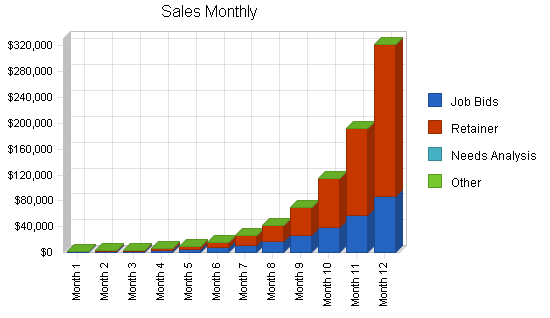
5.4 Milestones
The milestones table includes one listing each for the business plan and the marketing plan. Each of these are crucial to the long-term and short-term success of GMS. The other milestones are also important, but most are simply tasks necessary in starting up almost any business. Nevertheless, the most important milestone in this table is financial. The SBA loan will determine whether this company will have the working capital to operate for 5-12 months with little or no immediate revenue. If GMS cannot find the working capital to meet the minimum cash flow expectations set forth in this document, the company will dissolve and the owner will turn his talents elsewhere. Therefore, it is possible that the line item for “SBA Loan” may be changed to acquire family or friends as investors. Ideally it will not come to that and Mr. Dawson will be able to retain full control of the company, and direct it entirely based on his vision.
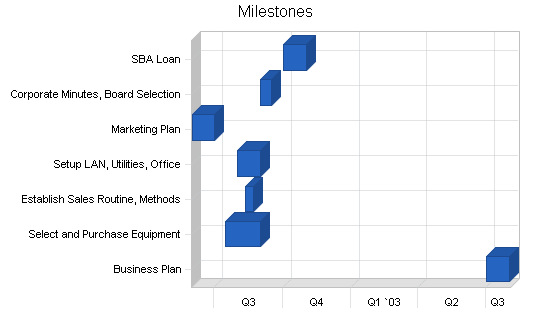
Management Summary management summary will include information about who's on your team and why they're the right people for the job, as well as your future hiring plans.">
The management team will initially consist of Bill Dawson. A Harvard MBA, and world-renowned consultant for major Fortune 500 companies, Mr. Dawson has built a reputation based his customer-centric approach to consulting, a relative anomaly in the world of high profile consulting. Many consultants are trained to believe they are right and the client was put on this earth to learn from the consultant. That is not the case for GMS, as the management team (Dawson) takes a different tact. The consultant acts as an interviewer, learning all that is possible to learn about the client in a one or two week period. As a management tool, this approach is very effective because it gives the sales team flexibility in dealing with potential customers, and relieves the uncomfortable pressure to close the sale.
Mr. Dawson’s approach to managing customers is also the approach he will take in dealing with his salespeople. GMS doesn’t need a hefty management structure, or administrative overhead. Many of those processes may be handled through outsourcing and Internet technology. On the contrary, the management structure at GMS is designed to reward the performer and educate the underperformer. Each salesperson is given a battery of psychological and rational tests, and most importantly, are screened based on how well they will fit into the Dawson management style. This leaves little to chance, and encourages a team atmosphere that remains light-hearted and fun.
6.1 Personnel Plan
This table demonstrates how GMS plans to start acquiring clients. One salesperson will be trained initially, and that person will later head a team of salespeople as the company expands. The promise of growth, and chance to work for a strategically positioned consulting business is enough to have three major players bidding for the job. Although each will see a major cut in salary from their current position, the chance to share in company profits (10%) and growth is enough to draw them to a low base, high commission position that offers no guarantees.
Financial Plan investor-ready personnel plan .">
The Financial Plan is based on a pending SBA loan, and a corresponding cash flow amount held in a highly liquid account.
7.1 Important Assumptions
The General Assumptions table explains various tax rates, personnel burden, and other financial inputs.
7.2 Break-even Analysis
The Break-even Analysis table is based on the assumption that each hour worked can be billed at approximately $70 per unit, and the employees will start at approximately $25/hour. This doesn’t include the cost of the payroll burden, however the assumptions are fairly accurate. Fixed costs are related to the lease and other monthly costs.

7.3 Projected Cash Flow
The following table and chart show the Projected Cash Flow figures for Growth Management and Strategies.

7.4 Projected Profit and Loss
The following table and charts are the Projected Profit and Loss and Gross Margin figures for Growth Management and Strategies.

7.5 Projected Balance Sheet
The following table is the Projected Balance Sheet for Growth Management and Strategies.
7.6 Business Ratios
Business ratios for the years of this plan are shown below. Industry profile ratios based on the Standard Industrial Classification (SIC) code 8742, Business Management Consultants, are shown for comparison.

The quickest way to turn a business idea into a business plan
Fill-in-the-blanks and automatic financials make it easy.
No thanks, I prefer writing 40-page documents.

Discover the world’s #1 plan building software
- Contact sales
Start free trial
What Is Organizational Strategy in Business? (Examples Included)

The most successful companies always have one eye on the future so they can not only survive but thrive. That doesn’t happen without an organizational strategy to plan for the organization’s long-term success.
Organizational strategy has many layers. We’ll first define the term and then go into the organizational strategy levels, as well as explain its importance in business. Then we’ll detail the key components that make up a thorough organizational strategy and throw in some free templates to get you started.
What Is Organizational Strategy?
Organizational strategy is the long-term organizational planning a company does to operate and achieve its strategic goals in the future. It involves how the company will allocate its resources to support business activities that lead to achieving those long-term goals.
Another reason to have an organizational strategy is that it provides a roadmap that can be shared across the company and illustrates how those long-term goals will be met. It’s not only communicative but helps management develop strategic plans so the company can accomplish its goals.
ProjectManager is award-winning project and portfolio management software that has powerful roadmaps that help managers track their initiatives, allocate resources and ensure that they’re on track to meet their long-term plans. Our roadmap is a Gantt chart that visually represents all of your strategic goals and related projects, including the steps necessary to accomplish them.

Use our roadmap to tie your strategy to the work that must be completed to achieve your goals. You can group and organize your various projects, manage resources and generate reports to get valuable insights on your progress and performance. Get started with ProjectManager today for free.
Organizational Strategy Levels
Organizational strategy goes deep and a company can lay the groundwork for their strategy in many different areas. This is called organizational strategy levels. It’s something that must be thought through at the beginning of strategy creation or when a company is making a strategic plan . To do this successfully means understanding the three levels of strategy to align company goals from top to bottom. Let’s explore those three levels below.
Related: Free Strategic Planning Templates for Excel and Word
1. Corporate Level Strategy
The corporate-level strategy is the highest, which means it’s also the broadest. Leadership creates this multi-tiered company plan to define, outline and achieve specific goals. Smaller companies can use corporate-level strategies to increase profits, while larger companies with multiple divisions and businesses will have more complex corporate-level strategies, such as entering new markets.
Examples of Corporate-Level Strategies
Organizational strategy is all about finding the best way to allocate resources to meet long-term goals. Here are some examples of how that’s done on the corporate level.
- Diversification: When you want to expand your business, this strategy encourages growth by adding new products or services.
- Retrenchment: This is when you consider changing your business model and is used when taking protective measures to keep the solvency of your business.
- Profit: Here a company will outline plans to increase revenue while keeping costs down.
- Stability: When the company is doing well, it seeks incremental growth by working with clients in its industry.
2. Business Level Strategy
A business-level strategy is made up of the strategic planning and implementation activities that will direct the company’s business units. This is usually used to gain a competitive advantage and create customer value in the market where the business unit operates.
Examples of Business-Level Strategies
This level of organizational strategy creates roadmaps to guide resource allocation and aligns different departments with the goal of sustainable growth, profitability and long-term success.
- Cost Leadership: This involves offering products or services at a lower cost than competitors by improving facilities, investing in tools, reducing overhead, etc.
- Differentiation: Here the company focuses on developing and marketing products that provide greater value rather than cheaper costs for the customer.
- Focused Cost Leadership: This targets a niche market and narrows the focus, allowing the company to better understand customer needs.
- Focused Differentiation: Here companies want to stand out from the competition while focusing on a smaller subset of their customer base to better anticipate customer needs.
3. Functional Level Strategy
A functional-level strategy means that the actions and goals assigned to various company departments support both business and corporate-level strategies. These strategies specify the outcomes that the company’s business departments achieve through daily operations . Therefore, functional-level strategy means that the corporate-level strategy needs participation across departments. Each department manager is responsible for leading their teams on these initiatives.
Examples of Functional-Level Strategies
- Human Resources: This department seeks out and hires highly-trained employees to solidify the workforce.
- Marketing: Works toward improving brand identification through both paid and unpaid efforts.
- Finance: Various initiatives include reducing operational expenses or implementing a new budgeting system.
- Product: Helps to develop the product or service, working to create efficiencies.

Get your free
Strategic Roadmap Template
Use this free Strategic Roadmap Template for Excel to manage your projects better.
Importance of Your Business’ Organizational Strategy
Organizational strategy has many benefits. Without having a strategy to direct your company and its strategic initiatives , the chance of reaching whatever goals you’ve set for yourself is unlikely. Rather than bet on luck to achieve your long-term goals, an organizational strategy will have a far greater impact. Here are some reasons why.
Shapes the Structure of the Organization
Organizational strategy aligns companies to a singular goal by defining what departments and roles are needed in planning the organizational strategy of a business. This creates transparency in a company’s operations that assists with better resource allocation and decision-making.
Aligns the Efforts of All Areas of the Organization
Organizational strategy also aligns everyone in the company to the common strategic goal of the company. This not only puts everyone on the same page as to understanding what their target is, but all work processes will also align to make the individual work, department and entire company more efficient. You can use a strategic roadmap to map the activities that each department will execute to better understand how different initiatives across your company work together.
Defines How Your Business Will Operate
The functional aspect of organizational strategy refers to how each part of the business will operate. It also speaks to how the company will contribute to implementing the business-level strategies and accomplishing the long-term, strategic goals of the business.
Key Components of the Organizational Strategy of a Business
When you’re developing an organizational strategy, first you have to have an idea of where you want to see the company in the long term. This will lead to the actions that the company must take to get there. That’s just two components of how a business deals with its organizational strategy. Below are all the key components of an organizational strategy for a business.
- Mission & Vision: The mission of the company and its vision for the future of the company should be brief written statements focusing on customers, employees and investors and its aspirations for the future.
- Organizational Structure: Create a system that outlines how business activities are directed to achieve the long-term goals of the company, such as rules, roles and responsibilities.
- Organizational Change: These are the actions a company takes to alter a major component of its organization. This could be anything from its culture, underlying technology or infrastructure to its internal processes.
- Organizational Culture: This refers to how an organization conducts itself as a whole in a different way from how others do. For example, how meetings are run, how new hires are trained, communication, benefits, etc.
- Strategic Plan: Here’s where the sequence of steps are outlined that will lead to achieving the company’s vision or long-term goals and objectives.
- Tactical Plan: Breaks the strategic plan into smaller objectives and goals and how they will be achieved through actions.
- Operational Plan: This will break down the day-to-day activities of the company. It will be at the project, business unit, functional or departmental level. These plans are highly detailed and action-based.
This free strategic roadmap template helps you visualize the projects and initiatives that each business department in your organization will execute to contribute to the accomplishment of strategic goals.
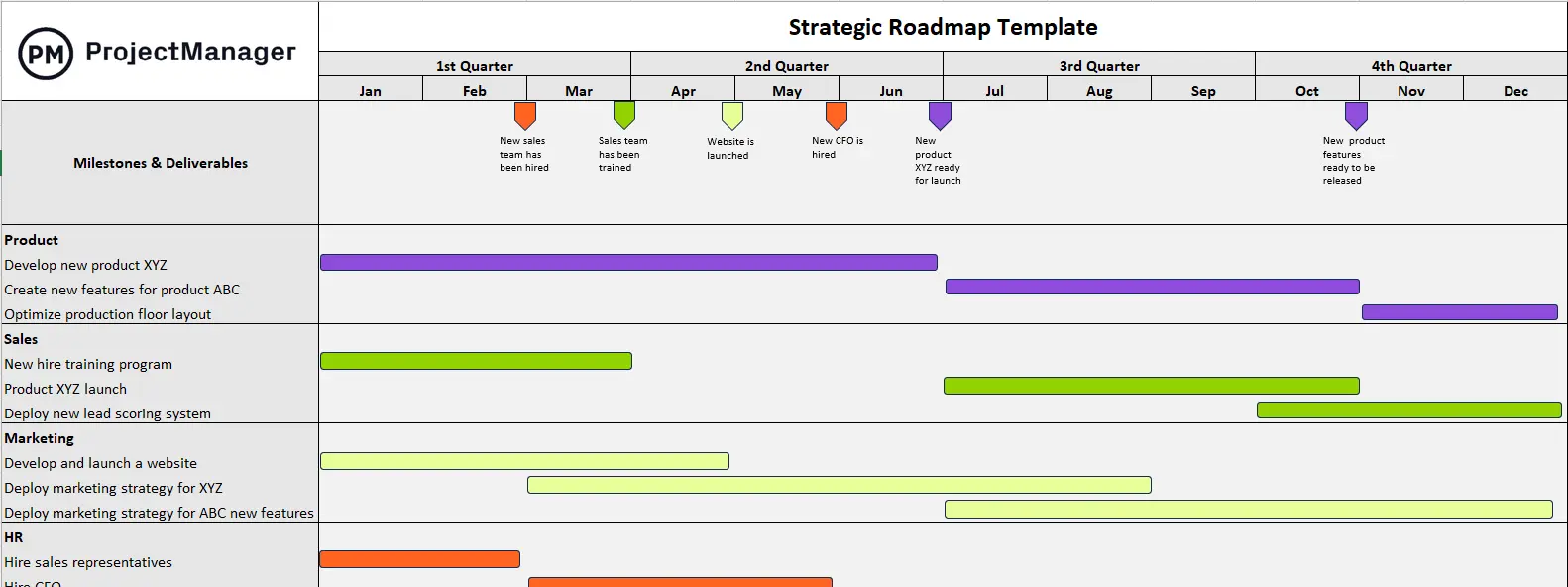
Related Organizational Strategy Templates
There are many steps to creating and implementing an organizational strategy. The following free strategic planning templates can help you figure out what’s the best approach and then create a plan to help you achieve your long-term goals.
Organizational Chart Template
An organizational chart can help you define the roles and responsibilities of your organization, which is part of the larger organizational strategy. Our free organizational chart for Excel is a visual flowchart illustrating the internal structure of your company.
Strategic Plan Template
Use our free strategic plan template for Word to define your vision, mission and business goals. It will help you develop a marketing plan, if necessary, and an operational plan. There’s also space to define your team and financial projections.
SWOT Analysis Template
SWOT stands for strengths, weaknesses, opportunities and threats. Our free SWOT analysis template for Excel helps you evaluate each of these four things as they relate to your business. This will inform your organizational strategy.
How ProjectManager Helps Track Your Organizational Strategy
While these free templates are a great starting point for your organizational strategy, they’re only going to take you so far. They’re not going to be helpful when implementing the strategic plan. That’s because these are static documents that must be manually updated and aren’t useful for collaboration across the organization. Project management software connects your teams and makes executing your plan more efficient. ProjectManager is award-winning project and portfolio management software that has the portfolio features you need to plan, manage and track multiple projects.
Track Resource Usage Throughout Your Organization
Our roadmap tool allows you to plan and allocate resource s across multiple projects and different departments in your company. When you onboard your teams, set their availability, including PTO, vacation time and global holidays for those teams that are working remotely. This makes assignments easier. Then check the color-coded workload chart to make sure no one is overallocated. If they are, you can balance their workload right from the chart to keep them working at capacity and productive.
Monitor Resources, Schedule and Budget in Real Time
Once you’ve made a plan, you’ll need to keep an eye on its progress and performance to ensure that it’s meeting your schedules and staying within your allocated resources. Get a high-level overview of all your projects in one place with our real-time portfolio dashboard. It collects live data automatically and displays it on easy-to-read graphs and charts. Now you can stay updated on time, costs, workload and more. Best of all, there’s no time-consuming and complicated setup as you’ll find with inferior alternatives. Whether using a project or portfolio dashboard, it’s ready when you are.

When you need more detailed information, use our customizable reporting features. You can get portfolio and status reports, as well as reports on variance, timesheets, workload and more. You can filter the reports as needed to show only the data you want to see. From there, share them with stakeholders in a variety of formats to keep them updated.
ProjectManager is online project and portfolio management software that connects teams whether they’re in the office, out in the field or anywhere in between. They can share files, comment at the task level and stay updated with email and in-app notifications. Join teams at Avis, Nestle and Siemens who use our software to deliver successful projects. Get started with ProjectManager today for free.

Deliver your projects on time and under budget
Start planning your projects.
How To Design a Professional Development Plan for Career Growth
Updated: March 11, 2024
Published: September 25, 2023
Climbing the corporate ladder or growing your own business requires constant learning and improvement.

Sometimes, you’ll learn from mistakes and general experience while working in the field daily. However, having a clear plan to develop your skills is necessary to grow in your profession and reach new heights over the long term.
A professional development plan is a tool that can ensure you gain and enhance your skills in a structured manner.
What is a professional development plan?
A professional development plan is a strategic road map designed to help individuals enhance their skills, knowledge, and expertise in their chosen field. It serves as a guide for setting goals, identifying areas for improvement, and mapping out actionable steps for continuous growth and career development.
Why do you need a professional development plan?
If you’re on a career path with opportunities to expand into new or higher positions, then odds are you need a plan to develop your skill set. Creating one can increase your odds of earning spots in roles you weren’t eligible for before.
For example, imagine a content editor who aspires to become a digital marketing strategist. In order to earn that promotion and move into that new role, they will need to improve their digital marketing skills. This may involve attending industry conferences and events, enrolling in online courses, earning a new degree, and seeking mentorship from experienced digital marketers, amongst other strategies.
By following a well-crafted plan, individuals can unlock their full potential and stay ahead in today’s competitive job market.
Benefits of a professional development plan
Here’s a look at some of the other benefits of having a professional development plan:
It clarifies your goals
A development plan defines specific goals you want to reach, such as earning a promotion, learning new technologies, improving your communication, and enhancing your leadership skills . For example, a software engineer in product design may set a goal to become proficient in a new programming language to expand their job opportunities.
It identifies strengths and weaknesses
Professional development plans don’t just guide your next steps — they review your current performance to identify strengths and weaknesses. By assessing your current skills and knowledge, you can identify areas where you excel and areas that need improvement. For instance, a sales professional may realize they excel at building relationships but lack negotiation skills.
It keeps you motivated and focused
Having a development plan keeps you motivated and focused on your career growth. It provides a sense of direction and purpose, helping you overcome obstacles and stay committed to your goals.
A human resources professional who has a goal of becoming a director within a year, for example, may become disenchanted with her goal if she doesn’t have a clear-cut way of achieving it. Building a professional development plan that outlines the skills she needs to foster and the strategies she can use to do so can keep her motivated over the long term.
It helps you maintain a competitive edge
The business landscape constantly evolves. A development plan ensures you stay up to date with industry trends and advancements. For instance, a health care professional may include continuous education in their plan, as well as a goal of attending conferences to stay informed about the latest medical breakthroughs.
It increases job satisfaction
A development plan allows you to pursue your passions and interests within your profession. By aligning your career goals with your personal aspirations, you can find greater fulfillment and satisfaction in your work. For example, a graphic designer may focus on developing their illustration skills to work on print projects that align with their artistic interests.
Remember, a professional development plan isn’t a one-time task, but an ongoing process that evolves with your career aspirations. As you accomplish pieces of your plan and start to realize your goals, you should constantly return to your plan and think about what else you may want to add.
How to create a professional development plan
It’s time to walk the talk of improving your professional skills. But where should you begin when creating your professional development plan?
Follow these five steps.
Step 1: Assess your current skills and knowledge
Creating a professional development plan starts with assessing your current skills and knowledge. This identifies your strengths and areas for improvement.
Here’s how to assess your current skills and knowledge:
- Conduct a self-assessment: Reflect on your current skills, knowledge, and experience. What things can you do well? What projects or tasks do you struggle with the most? Then determine where you’d like to invest time to grow professionally.
- Seek feedback: Request feedback from your supervisors, colleagues, or mentors. They can provide valuable insights into your performance and areas where you can further develop your skills.
- Evaluate performance reviews: Review your past performance evaluations or appraisals to identify any recurring feedback or areas for improvement.
- Identify skill gaps: Compare your current skills and knowledge with the requirements of your desired career path or future roles. Identify any gaps that need addressing to achieve your professional goals.
By assessing your current skills and knowledge, you gain a clear understanding of where you stand professionally and can identify the areas that require further development.
Step 2: Set SMART goals
After assessing your current skills and knowledge, the next step is to set SMART goals. SMART is an acronym that stands for Specific, Measurable, Achievable, Relevant, and Time-Bound. Setting SMART goals ensures your objectives are clear, actionable, and aligned with your professional growth.
Here’s how you can set SMART goals:
1. Specific: Clearly define what you want to achieve. Be specific about the skills or knowledge you want to develop and the outcomes you expect.
Example: Improve my presentation skills to deliver engaging presentations to clients and stakeholders confidently.
2. Measurable: Set criteria to measure your progress and success. This tracks your development and increases motivation.
Example: Increase my presentation skills rating from 7 to 9 on a scale of 1-10 within six months.
3. Achievable: Ensure your goals are realistic and attainable. Consider your available resources, time, and capabilities.
Example: Attend presentation skills workshops, practice presentations regularly, and seek feedback from colleagues and mentors.
4. Relevant: Align your goals with your career aspirations and the needs of your role or industry. Ensure that they contribute to your professional growth.
Example: Enhance presentation skills to excel in client-facing roles and contribute to business development efforts.
5. Time-Bound: Set a deadline or timeline for achieving your goals. This adds a sense of urgency and helps you stay focused.
Example: Improve presentation skills within six months by attending two workshops, practicing presentations weekly, and receiving feedback from colleagues.
When we put all those pieces together, we get a single goal that says, “Improve presentation skills within six months by attending two workshops, practicing presentations weekly, and receiving feedback from colleagues.”
Step 3: Identify development opportunities
After assessing your skills and setting SMART goals, the next step is identifying development opportunities. This involves finding opportunities to enhance your knowledge and skills.
Here are several ideas:
- Research available resources: Conduct thorough research to identify the resources and opportunities that can support your professional growth. This may include online platforms, books, industry publications, professional associations, and training programs.
- Attend workshops, conferences, and online courses: Participating in workshops, conferences, and online courses can provide valuable learning experiences and help you acquire new skills and knowledge. Look for relevant events and courses that align with your goals and interests.
- Seek out mentorship: Finding a mentor experienced in your field can provide guidance, support, and valuable insights. Seek out professionals who have achieved success in areas you want to develop and establish a mentorship relationship with them.
- Find networking opportunities: Engaging in networking activities allows you to connect with professionals in your industry and expand your professional network. Attend industry events, join professional groups or associations, and participate in online communities to build connections and learn from others.
The more resources and opportunities you explore, the greater the possibility you’ll have to enhance your skills and grow your career. So add one or more from the list to your professional development plan.
Step 4: Create an action plan
Once you’ve identified development opportunities, create an action plan. Break down your goals into smaller, manageable milestones and create a timeline and schedule for your development activities.
Here’s an example of how you can create an effective action plan:
1. Breaking down goals into smaller milestones: Divide your goals into smaller, achievable milestones. This helps you track your progress and stay motivated as you accomplish each milestone. Break down your goals into specific tasks or activities.
Example: If your goal is to improve your project management skills, your milestones could be completing a project management course, applying the learned skills to a real-life project, and receiving positive feedback from stakeholders.
2. Creating a timeline: Set a timeline for each milestone and the overall completion of your goals. Consider the resources available to you and any external deadlines or constraints. Be realistic in your timeline to ensure you have enough time to complete each milestone effectively.
Example: You might allocate three months for completing the project management course, two months for applying the skills to a real-life project, and one month for receiving feedback and making improvements.
3. Scheduling development activities: Create a schedule for your development activities. Determine when and how often you’ll engage in each activity, such as attending workshops and networking events, or working on specific tasks. This helps you allocate time and resources effectively.
Example: You might attend a project management workshop every other week, spend two hours each week practicing project management techniques, and allocate dedicated time for networking activities on a monthly basis.
Creating an action plan establishes a clear road map for achieving your goals. This helps you stay organized, focused, and accountable, and ensures you take a structured approach to reaching your goals.
Step 5: Implement and review the plan
With your action plan in place, it’s time to implement it and regularly review your progress.
Here’s how you can effectively implement and review your professional development plan:
- Stay committed to the plan: Prioritize the activities outlined in your action plan. Make a conscious effort to allocate time and resources for your development activities and treat them as a priority.
- Schedule regular check-ins: Set specific dates or intervals to check in on your progress. This allows you to assess how well you’re sticking to your plan and achieving your milestones. Regular check-ins help you stay accountable and make any necessary adjustments to your plan if needed.
- Review your progress: During your check-ins, review your progress toward your goals and milestones. Evaluate what’s working well and which areas need improvement. Reflect on the outcomes of your development activities and assess whether they’re helping you achieve your desired outcomes.
- Make adjustments: Based on your progress reviews, make any necessary adjustments to your plan. This may involve modifying timelines, revising milestones, or exploring additional development opportunities. Stay flexible and adapt your plan as needed to ensure continued growth and success.
- Celebrate achievements: Recognize and celebrate your achievements along the way. Acknowledge the progress you’ve made and the skills you’ve developed. This helps to maintain motivation and positive momentum in your professional development journey.
Measuring success and adjusting your professional development plan are crucial for growth. By tracking progress, identifying areas for improvement, and making necessary adjustments, you can ensure your plan remains effective and aligned with your goals. So stay proactive and adaptable to achieve continuous professional growth.
hbspt.cta._relativeUrls=true;hbspt.cta.load(53, 'ad22bdd9-fd50-4b35-a4f5-7586f5a61a1e', {"useNewLoader":"true","region":"na1"});
What did you think of this article .
Give Feedback

Don't forget to share this post!
Related articles.

Creating a Fulfilling Workplace: 5 Guaranteed Ways to Boost Job Satisfaction on Your Team

30+ Positive Feedback Examples Your Employees Need to Hear

Guide to Onboarding vs. Orientation

Behavioral Competencies: Putting Together the Best Team

56 Core Company Values That Will Shape Your Culture & Inspire Your Employees

How To Use a Hiring Committee for Your Company

How To Avoid Manager Burnout

How To Create a Job Requisition

Paid Holidays: An Explainer

How To Craft a PTO Policy
Outline your company's marketing strategy in one simple, coherent plan.
Marketing software that helps you drive revenue, save time and resources, and measure and optimize your investments — all on one easy-to-use platform
An official website of the United States Government
- Kreyòl ayisyen
- Search Toggle search Search Include Historical Content - Any - No Include Historical Content - Any - No Search
- Menu Toggle menu
- INFORMATION FOR…
- Individuals
- Business & Self Employed
- Charities and Nonprofits
- International Taxpayers
- Federal State and Local Governments
- Indian Tribal Governments
- Tax Exempt Bonds
- FILING FOR INDIVIDUALS
- How to File
- When to File
- Where to File
- Update Your Information
- Get Your Tax Record
- Apply for an Employer ID Number (EIN)
- Check Your Amended Return Status
- Get an Identity Protection PIN (IP PIN)
- File Your Taxes for Free
- Bank Account (Direct Pay)
- Debit or Credit Card
- Payment Plan (Installment Agreement)
- Electronic Federal Tax Payment System (EFTPS)
- Your Online Account
- Tax Withholding Estimator
- Estimated Taxes
- Where's My Refund
- What to Expect
- Direct Deposit
- Reduced Refunds
- Amend Return
Credits & Deductions
- INFORMATION FOR...
- Businesses & Self-Employed
- Earned Income Credit (EITC)
- Child Tax Credit
- Clean Energy and Vehicle Credits
- Standard Deduction
- Retirement Plans
Forms & Instructions
- POPULAR FORMS & INSTRUCTIONS
- Form 1040 Instructions
- Form 4506-T
- POPULAR FOR TAX PROS
- Form 1040-X
- Circular 230
IRS Direct File pilot
More in irs inflation reduction act strategic operating plan.
- Strategic Operating Plan
File your 2023 federal tax return online for free, directly with IRS with the IRS Direct File pilot.
You can use it if you:
- Live in 1 of 12 pilot states
- Report only certain types of income
- Claim only certain credits
- Take only certain deductions
File online for free with IRS Direct File
See Direct File pilot news for the latest updates.
Get live online support
If you need help, you can chat live with one of our customer service representatives Monday through Friday, 7 a.m. to 10 p.m. ET.
Our Direct File pilot representatives offer technical support and answer basic tax law questions in English and Spanish. They can’t access your IRS account data. They will send you to other IRS help for questions or issues beyond the Direct File pilot
Learn if Direct File is right for you
Direct File walks you through the processes of preparing your return. You’ll follow a step-by-step checklist that guides you through filing and helps you easily track your progress. When you finish, Direct File shows you a clear summary of your 2023 federal taxes based on the information you entered.
Preview how Direct File guides you through the process and other key features with our IRS Direct File Pilot Overview YouTube videos in English and Spanish .
Participating pilot states
You may be eligible to use Direct File if you lived in one of these pilot states in 2023:
- Massachusetts
- New Hampshire
- South Dakota
- Washington state
You can’t use Direct File pilot if you did not live in one of the 12 participating states in 2023.
State returns in Arizona, California, Massachusetts and New York
The Direct File pilot doesn't prepare state returns. However, if you live in Arizona, California, Massachusetts or New York, the Direct File pilot guides you to a state-supported tool you can use to prepare and file your state tax return.
If you live in Washington state, Direct File guides you to a state site where you can apply for the Working Families Tax Credit when you file your federal return with the Direct File pilot.
Types of income, tax credits and deductions
You may be eligible to join the pilot if you live in a pilot state and report these items on your 2023 federal tax return:
Income You may be eligible to join the pilot if you report these income types on your 2023 federal tax return:
- W-2 wage income
- SSA-1099 Social Security income
- 1099-G unemployment compensation
- 1099- INT interest income of $1,500 or less
You can’t use Direct File if you have other types of income, such as gig economy or business income .
- Earned Income Tax Credit
- Credit for Other Dependents
You can’t use Direct File if you claim other credits like the Child and Dependent Care Credit , Saver's Credit or the Premium Tax Credit .
- Standard deduction
- Student loan interest
- Educator expenses
You can’t use Direct File if you itemize deductions .
Sign-in to Direct File securely
You'll need to verify your identity and securely sign in to file your return with the Direct File pilot.
The IRS lets you access most tax tools with one account using the same login and password. For example, if you already have an IRS online account, you can use it for the pilot. If not, you will be directed to create an account to verify your identity. Once your identity is verified, you can start preparing your return with Direct File.
- Direct File pilot news
- Subscribe to the Direct File pilot newsletter
- Direct File pilot outreach materials
- IRS Inflation Reduction Act Strategic Operating Plan
IRS Direct File report PDF
- Letter from Commissioner Werfel to Secretary Yellen to accompany Direct File report PDF
- Letter from Deputy Secretary Adeyemo to Commissioner Werfel PDF
- Letter from Commissioner Werfel to Federation of Tax Administrators PDF

An official website of the United States government
Here’s how you know
Official websites use .gov A .gov website belongs to an official government organization in the United States.
Secure .gov websites use HTTPS A lock ( ) or https:// means you’ve safely connected to the .gov website. Share sensitive information only on official, secure websites.

- Explore sell to government
- Ways you can sell to government
- How to access contract opportunities
- Conduct market research
- Register your business
- Certify as a small business
- Become a schedule holder
- Market your business
- Research active solicitations
- Respond to a solicitation
- What to expect during the award process
- Comply with contractual requirements
- Handle contract modifications
- Monitor past performance evaluations
- Explore real estate
- 3D-4D building information modeling
- Art in architecture | Fine arts
- Computer-aided design standards
- Commissioning
- Design excellence
- Engineering
- Project management information system
- Spatial data management
- Facilities operations
- Smart buildings
- Tenant services
- Utility services
- Water quality management
- Explore historic buildings
- Heritage tourism
- Historic preservation policy, tools and resources
- Historic building stewardship
- Videos, pictures, posters and more
- NEPA implementation
- Courthouse program
- Land ports of entry
- Prospectus library
- Regional buildings
- Renting property
- Visiting public buildings
- Real property disposal
- Reimbursable services (RWA)
- Rental policy and procedures
- Site selection and relocation
- For businesses seeking opportunities
- For federal customers
- For workers in federal buildings
- Explore policy and regulations
- Acquisition management policy
- Aviation management policy
- Information technology policy
- Real property management policy
- Relocation management policy
- Travel management policy
- Vehicle management policy
- Federal acquisition regulations
- Federal management regulations
- Federal travel regulations
- GSA acquisition manual
- Managing the federal rulemaking process
- Explore small business
- Explore business models
- Research the federal market
- Forecast of contracting opportunities
- Events and contacts
- Explore travel
- Per diem rates
- Transportation (airfare rates, POV rates, etc.)
- State tax exemption
- Travel charge card
- Conferences and meetings
- E-gov travel service (ETS)
- Travel category schedule
- Federal travel regulation
- Travel policy
- Explore technology
- Cloud computing services
- Cybersecurity products and services
- Data center services
- Hardware products and services
- Professional IT services
- Software products and services
- Telecommunications and network services
- Work with small businesses
- Governmentwide acquisition contracts
- MAS information technology
- Software purchase agreements
- Cybersecurity
- Digital strategy
- Emerging citizen technology
- Federal identity, credentials, and access management
- Mobile government
- Technology modernization fund
- Explore about us
- Annual reports
- Mission and strategic goals
- Role in presidential transitions
- Get an internship
- Launch your career
- Elevate your professional career
- Discover special hiring paths
- Events and training
- Agency blog
- Congressional testimony
- GSA does that podcast
- News releases
- Leadership directory
- Staff directory
- Office of the administrator
- Federal Acquisition Service
- Public Buildings Service
- Staff offices
- Board of Contract Appeals
- Office of Inspector General
- Region 1 | New England
- Region 2 | Northeast and Caribbean
- Region 3 | Mid-Atlantic
- Region 4 | Southeast Sunbelt
- Region 5 | Great Lakes
- Region 6 | Heartland
- Region 7 | Greater Southwest
- Region 8 | Rocky Mountain
- Region 9 | Pacific Rim
- Region 10 | Northwest/Arctic
- Region 11 | National Capital Region
- Per Diem Lookup
Privately owned vehicle (POV) mileage reimbursement rates
GSA has adjusted all POV mileage reimbursement rates effective January 1, 2024.
* Airplane nautical miles (NMs) should be converted into statute miles (SMs) or regular miles when submitting a voucher using the formula (1 NM equals 1.15077945 SMs).
For calculating the mileage difference between airports, please visit the U.S. Department of Transportation's Inter-Airport Distance website.
QUESTIONS: For all travel policy questions, email [email protected] .
Have travel policy questions? Use our ' Have a Question? ' site
PER DIEM LOOK-UP
1 choose a location.
Error, The Per Diem API is not responding. Please try again later.
No results could be found for the location you've entered.
Rates for Alaska, Hawaii, U.S. Territories and Possessions are set by the Department of Defense .
Rates for foreign countries are set by the State Department .
2 Choose a date
Rates are available between 10/1/2021 and 09/30/2024.
The End Date of your trip can not occur before the Start Date.
Traveler reimbursement is based on the location of the work activities and not the accommodations, unless lodging is not available at the work activity, then the agency may authorize the rate where lodging is obtained.
Unless otherwise specified, the per diem locality is defined as "all locations within, or entirely surrounded by, the corporate limits of the key city, including independent entities located within those boundaries."
Per diem localities with county definitions shall include "all locations within, or entirely surrounded by, the corporate limits of the key city as well as the boundaries of the listed counties, including independent entities located within the boundaries of the key city and the listed counties (unless otherwise listed separately)."
When a military installation or Government - related facility(whether or not specifically named) is located partially within more than one city or county boundary, the applicable per diem rate for the entire installation or facility is the higher of the rates which apply to the cities and / or counties, even though part(s) of such activities may be located outside the defined per diem locality.

IMAGES
VIDEO
COMMENTS
4 Steps in the Strategy Implementation Process. 1. Handle Tension. Making tough choices isn't easy, and you need to manage any tension that arises with change. In strategy implementation, tension often exists between innovating to grow your business and controlling internal processes and procedures.
Step 1: Set and communicate clear, strategic goals. The first step is where your strategic plan and your strategy implementation overlap. To implement a new strategy, you first must identify clear and attainable goals. As with all things, communication is key. Your goals should include your vision and mission statements, long-term goals, and KPIs .
How to implement an effective strategic plan As your business goes through the stages of strategic planning, it will take steps to build the plan. The following steps can be helpful in creating an effective strategic plan: Study the overall market. Complete a SWOT analysis. Define your business goals. Develop departmental goals. Set short-term ...
A strategic implementation plan (SIP) is the document that you use to define your implementation strategy. Typically, it outlines the resources, assumptions, short- and long-term outcomes, roles and responsibilities, and budget. (Later on, we'll show you how to create one.) An SIP is often integrated with an execution plan, but the two are ...
Free Implementation Plan Templates. We gathered seven free implementation plan templates, complete with customizable sample copy. These templates serve as invaluable tools for professionals, ensuring that each step of the implementation process is thoughtfully planned and executed. Included on this page, you'll find a project implementation ...
Strategy Map: A strategy map is a visual tool designed to communicate a strategic plan and achieve high-level business goals. The best model for any given organization will depend on the nature of the organization, the specific strategies being implemented, and the context in which they operate. ... Strategy Implementation Example. Let's look ...
How to create an implementation plan in 6 steps. If you want your implementation plan to be comprehensive and beneficial to your project team, you'll need to follow specific steps and include the right components. Use the following steps when creating your plan to reduce the risk of gaps in your strategy. 1. Define goals.
For example, strategic implementation within a business context might involve developing and then executing a new marketing plan to help increase sales of the company's products to consumers. The Houston Chronicle: The process that puts plans and strategies into action to reach goals. A strategic plan is a written document that lays out the ...
6. Continue to Review Performance. While these tools can be helpful for any strategy implementation, they don't guarantee success without constant review and oversight. A successful strategic plan that drives value for a business and its customers requires continuous performance reviews and improvements.
📚Recommended read: Free Implementation Plan Templates And Examples. Step #4: Deal with business-as-usual. ... We can tell you without question that when our customers follow the above process, their strategy implementation plan succeeds far more often than it fails. This is an integral component of effective strategic management and shouldn ...
Project implementation, or project execution, is the process of completing tasks to deliver a project successfully. These tasks are initially described in the project plan, a comprehensive document that covers all areas of project management. However, a secondary action plan, known as an implementation plan, should be created to help team ...
The strategy implementation plan template is for teams and organizations of all sizes and industries. Whether you are creating a plan for a small business or a large corporation, this template will help you create a plan that can be tailored to your specific needs. 1. Define clear examples of your focus areas. Focus areas are the main goals and ...
Step 1: Assess your current business strategy and business environment. Before you can define where you're going, you first need to define where you are. Understanding the external environment, including market trends and competitive landscape, is crucial in the initial assessment phase of strategic planning.
Every implementation would require undergoing different phases before it will be executed to the public. Here are the following stages that you may follow when making a strategic plan. Analysis and evaluation - evaluation of the internal and external influences of an organization. Strategy articulation - development of organizational plans.
A quality strategy and implementation summary in business plan addresses strategy and implementation by outlining the strategic assumptions, supported by market analysis. If the analysis is thorough, the entrepreneur conducted a SWOT analysis and included contingency planning. An entrepreneur may experience difficulties, but those difficulties ...
Here is an example of a business implementation plan and how it differs from the actual strategy of a business plan objective: Business plan objective: To reduce employee turnover by 25% within the next two years; Strategies to achieve objective: By improving the hiring and onboarding process, employee feedback channels and benefits or perks ...
The Implementation Plan Template is designed to guide implementation teams in developing a plan for implementation across the four stages: exploration, installation, initial implementation and full implementation. The implementation plan should be collaboratively developed by the implementation team together with community partners and members ...
2) Create The Mission, Vision, And Values. Once you've appointed a leader, it's time to create the mission, vision, and values of your strategy. The leader doesn't have to do this all on their own. They can, of course, if the business is small enough. But even a mom-and-pop coffee shop can benefit from a diverse range of input at this point.
Describe Your Services or Products. The business plan should have a section that explains the services or products that you're offering. This is the part where you can also describe how they fit ...
Web Applications is a start-up company that is designed to offer Web-based business management applications. Web Applications has developed an Internet-based application called Online Office Manager, for which a patent is pending. Online Office Manager allows businesses and individuals to keep in touch even when working in different locations.
Strategy Implementation Plan Template. Discover our comprehensive Strategy Implementation Plan Template, an effective roadmap for executing your strategic initiatives, evaluating progress, ensuring team alignment, and achieving business objectives. 1. Identify strategic objectives. Conduct a thorough market analysis.
5. The Overwhelm Overload: The Problem: An ambitious plan with too many goals and actions leads to paralysis. Employees become unsure where to begin. The Fix: Prioritization is key. Focus on a set of high-impact objectives and eliminate non-critical actions. Ensure goals are clear, measurable, and achievable. 6.
Explore a real-world business consulting business plan example and download a free template with this information to start writing your own business plan. ... Strategy and Implementation Summary . GMS will pursue a strategy in line with the experience of the owner, and implementation will be performance based and follow a clear path. ...
Strategic plans and implementation plans go hand-in-hand. A strategic plan outlines at a high level what strategies you're going to take to achieve a business goal. An implementation plan, on the other hand, is a step-by-step action plan that includes the exact actions you'll take to accomplish the goal.
2. Business Level Strategy. A business-level strategy is made up of the strategic planning and implementation activities that will direct the company's business units. This is usually used to gain a competitive advantage and create customer value in the market where the business unit operates. Examples of Business-Level Strategies
Product strategy is the overarching plan explaining what your business aims to achieve with a product or feature. It includes how you plan to create the product, how it will impact buyers, and how it helps achieve your business goals. It guides the ideation, creation, and launch of your product. Though some products — such as the microwave ...
Step 1: Dive into the unknown to initiate risk assessment and business impact analysis (BIA) Assess how much revenue could be lost during a specific disruption period. In practice, this also involves analyzing historical data on incidents like natural disasters, cyberattacks, or supply chain disruptions.
Step 1: Assess your current skills and knowledge. Creating a professional development plan starts with assessing your current skills and knowledge. This identifies your strengths and areas for improvement. Conduct a self-assessment: Reflect on your current skills, knowledge, and experience.
Strategic Operating Plan. File your 2023 federal tax return online for free, directly with IRS with the IRS Direct File pilot. You can use it if you: Live in 1 of 12 pilot states. Report only certain types of income. Claim only certain credits.
GSA has adjusted all POV mileage reimbursement rates effective January 1, 2024. Modes of transportation. Effective/Applicability date. Rate per mile. Airplane*. January 1, 2024. $1.76. If use of privately owned automobile is authorized or if no Government-furnished automobile is available. January 1, 2024.